A list of fiendish characters found in Disney's Mickey Mouse Comic Universe.
Click here to return to the main list.
- Click here to go to the protagonist list.
- Click here to go to the friend list.
- Click here to go to the animal list.
- Click here to go to the antagonist list.
- Click here to go to the otherworlder list.
- Click here to go to the subseries character list.
- Click here for more options.
Keep in mind that since the characters and series have been around for so long, whether a character displays certain traits or not in any given story largely depends on the artist, the writer, or the time period.
Thieves
The Gleam

The Gleam and his partner-in-crime are jewel thieves who present themselves as a couple to gain their victims' trust. The Gleam utilizes a hypnotizing device disguised as a jewel on his turban to force people to help him and the police to forget about him. The duo went by the names Dudley and Martha Mousegomery as civilians, but if those are their real names is not confirmed.
- Brownface: The Gleam wears makeup to make his skin look darker.
- Ethnic Magician: Subverted, as the Gleam turns out to be a disguise on the final pages.
- Henpecked Husband: Subverted, as it's only an act to draw away suspicion. To make up for his robbery disappearances, Dudley pretends to get tired of parties and find places to take a nap. Martha plays the part of frustrated wife fed up with his lack of manners.
- Mind Control: Anyone under the Gleam's influence remains vulnerable to his manipulations - regardless of proximity - until he frees them.
- Mind-Control Device: An electronic hypnotizing device disguised as a jewel on his turban.
- Outlaw Couple: They're wanted internationally.
- Wounded Gazelle Gambit: Martha pretends to be the Gleam's first victim to get herself and Dudley off the suspect list.
The Boss

An opportunistic but well-prepared jewel thief. His civilian identity is Mr. Roxx, owner of Roxx's Fine Jewels. He has a henchman named Spike.
- Coat, Hat, Mask: The villainous sort. The Boss wears practical clothes and a mask that conceals half his face.
- Don't Look At Me: A mask is not enough for The Boss, no! He also maintains a strict rule that Spike has to blindfold himself whenever they meet. Same for any prisoners, although lenience is given if he plans to off them anyway. It backfires when he's recognized by his voice instead.
- Fat Bastard: He is large and imposing, emphasized by his demanding presence, as well as a dirty crook.
- Frame-Up: he tried to blame the stolen jewels on Mickey and later Minnie too. While Chief O'Hara incompetence in going after his two friends with a more than clean record prior is his to blame, fact is that Mr. Roxx was the one that bellowed him on that path.
- Inside Job: As owner of Roxx's Fine Jewels, he was entrusted with the treasure by the rajah. It made it easy for him to come up with a plan to make them disappear while looking innocent himself. For the purpose of the plan, Spike dressed up as the rajah's guard so Mickey as the driver of the armed truck would be throroughly caught by surprise.
- No Honor Among Thieves: The Boss never intended to give Spike a fair share, but still a share. When due to circumstances Spike couldn't blindfold himself in the Boss's presence, the Boss K.O.'ed him and intended to escape with the entire treasure.
Dinny the Dandy

A simple pickpocket who hit it big when he found a way to fool burglar alarms.
- Clothes Make the Superman: His ability to bypass the electric eyes of the security systems comes from the fine-spun copper cloth his (fancy) robber outfit was made of. The copper let the current go through unhindered.
- The Dandy: His very nickname is "the dandy".
- Make It Look Like an Accident: He tried to off Mickey by driving off a cliff with the victim in the passenger seat and jumping out just in time himself. If Mickey was found at all, it would look like an accident.
- Phantom Thief: Smart, ruthless but sophisticated, well-dressed, thwarted only by Mickey. Also, the title of his debut comic.
- Rags to Riches: Not literal rags because he's too proud for that, but as another crook notes "Huh! That guy was always a cheap pickpocket who thought a dime was a lot of money... Now look at him!".
- Why Won't You Die?: He first tricked the police into beating the daylight out of Mickey and that "soft" approach did not stop him. Thus he tried to get rid of him by driving him off a cliff. Needless to say, his mood did not improve when he found Mickey snooping in his room a day later. He knocked him out and locked him up in a closet to dispose off later, but Mickey escaped and called the police on him now that he had the evidence together.
"High-Pockets" and "Low-Pockets"

A duo of pickpockets.
- Actually, That's My Assistant: You'd think that the long-legged "High-Pockets" is the better runner, but you'd be wrong. It's the short-legged "Low-Pockets" who you need to look out for if you try to escape them.
- Coordinated Clothes: They wear the same outfit, differing only in color (depends on the publication), shoe type, and coat length.
- Cunning Like a Fox: They're foxes and for the longest time managed to stay out of jail because the police could get nothing on them.
- Hoist by His Own Petard: With a whiff of Mugging the Monster. In "Postman's Puzzle", they rob an elderly man of one bill — worth $50.000. They go through a lot of trouble to get it back when they lose it through circumstances and they only reobtain it in the presence of the police. The police never had been able to acquire any proof against them and the duo thinks they can get away once more by claiming the bill is theirs. O'Hara is willing to believe that and promptly arrests them for being in the possession of counterfeit money.
- Percussive Pickpocket: "High-Pockets" bumps into a victim to give "Low-Pockets" an opening to pick their pockets.
- No Name Given: Their civilian names aren't given.
- Theme Naming: "High-Pockets" has long legs and thus his pockets are located high, while his colleague "Low-Pockets" has short legs and thus his pockets are located low.
The King of Diamonds

An infamous diamond smuggler.
- Gem-Encrusted: He's obnoxiously stuck diamonds on his everyday clothes just to live up to his title.
- Cement Shoes: The King pulls a variant on Goofy and Mickey. He takes them on a cruise with his submarine, but on account of the submarine being very small, he ties them to the periscope. The two barely survive their time under water, being brought back up timely only because they tricked the King into acting rash.
- Hoist by His Own Petard: His final escape is prevented by Goofy K.O.'ing him with a well-aimed golf shot performed with the King's own cover-up equipment. Goofy even gets in a nice one-liner for the occasion: "After all, he may be thuh King of Diamonds, but I guess I'm thuh Ace of Clubs!".
- Milkman Conspiracy: The "world's greatest diamond smuggler" and he operates through a seaside golf course!
- No Honor Among Thieves: When his golf course cover-up is at risk of being uncovered by the police, his course of action is to bring his diamonds to safety instead of untying his partner-in-crime. Goofy and Mickey even comment on it, but consider it in their favor as it means they only have to deal with the King himself.
- Red Baron: Overlaps with No Name Given, as he's only referred to as the King of Diamonds in his one story. His henchman or partner-in-crime gets no name at all.
Doc Finkelstein and Shrimp
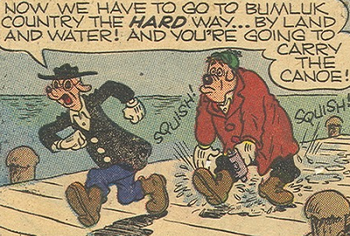
A pair of criminals who specialize in artifact theft and falsely acquiring natural resources.
- Brains and Brawn: The difference is minimal, but on average Finkelstein prefers caution and manipulation while Shrimp is more proactive and inclined to resort to violence.
- Cool Shades: Definitely the most distinctive design detail of Doc Finkelstein.
- Fat and Skinny: Shrimp is the fat one, Doc Finkelstein the skinny one.
- Heterosexual Life-Partners: Finkelstein and Shrimp always work together.
- Named by the Adaptation: The duo used the names Professor Artifact and Lurk in their debut comic, but those were false names and no true names were given. They received those from the Egmont Group once the two started being used by its writer. None of those comic stories have been published in the USA so far.
Purplebeard II

The sole descendent of Purplebeard the Pirate (his name is not given in the comic; "Purplebeard II" is a nickname for purposes of this entry) who sought for his ancestor's final treasure. He's got a henchman named Willy Rat.
- Beatnik: Purplebeard II does not have the behavior, but he has the beret and the Cool Shades. The Cool Shades are relevant when Willy has to dress up as Millicent to fool her niece Minnie, who'd come to visit with Mickey. Purplebeard II gives him his shades to help hide his face.
- Captain Colorbeard: The pirate at the root of the predicament is named Purplebeard. He hid the diamond away in one of many barrels containing his personal dye powder, which caused it to acquire a thick coat and be unrecognizable as anything but an ordinary rock.
- Death Trap: Purplebeard II and Willy tied up Millicent, Minnie, and Mickey and put them in a boat to drift down the river into the open sea to drown, starve, or get fried by the sun. Whichever would've come first.
- Dick Dastardly Stops to Cheat: By all means, the diamond is his inheritance. The letter proves it was intended to go to Purplebeard's descendents, and he's the only one. At most he'd have to share some of its worth with Millicent as the one who found it and who owns the land it was hidden on, but he could've gotten a nifty fortune legally.
- Identical Grandson: Purplebeard II's generation in comparison to Purplebeard I isn't given, but he's probably his great-grandson or his great-great-grandson. As Millicent puts it, she "thought [she] was looking at a ghost" when Purplebeard II knocked on her door.
- Pirate Booty: Purplebeard the Pirate had hidden a huge uncut diamond in his barrels of dye powder. Millicent discovered these as a little girl and when she inherited the house took a barrel to keep flowers in. The powder-coated rock she found at the bottom she used as a doorstop.
- No Name Given: As per the intro, the descendent's name is not given.
The Collector

A collector of rare things who readily resorts to underhanded means to acquire his prizes. He regularly hires Pete.
- Collector of the Strange: The theme of his collection would be described by "Hey, that's unusual. I want that.". Can be anything, from the Olympic flame to holes.
- The Faceless: A joint effort of Face Framed in Shadow, Cool Shades, and a head that's barely distinct from the rest of his body. His lack of hair also does a number on making him distinguishable because he utterly lacks anything notable.
The Mimic
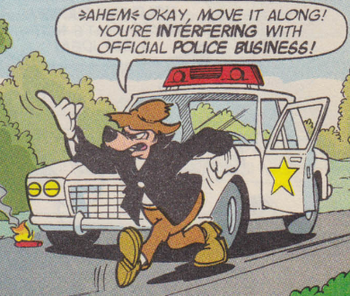
The Mimic aka The Man of Nine Hundred and Ninety-Nine Voices aka Vinny Trillykwist. A skilled voice changer who likes to mock his victims with dummies.
- Calling Card: He leaves dummies dressed up as either his victims or who his victims think they are talking to as a sign of mockery.
- Meaningful Name: "Vinny Trillykwist" = "ventriloquist".
- Shout-Out: "The Man of Nine Hundred and Ninety-Nine Voices" is derived from "The Man of a Thousand Voices", a title given to the prolific voice actor Mel Blanc.
- Voice Changeling: His particular skill.
- Verbal Tic: If the sound "ahem" shows up in someone's speech, it's the Mimic.
Ms. Vixen

A French burglar with a flirtatious personality.
- Classy Cat-Burglar: As classic as the archetype comes.
- Cool Mask: She has a rather bulky mask in comparison to the elegance of the rest of her Spy Catsuit outfit. And although not The Faceless, Mickey and his team have yet to see her without her mask.
- Cunning Like a Fox: She is a fox and gets what she is after at the end of her one story without any penalty. Granted, she's following orders from Doublecross, but when he continues the plan without her, he isn't nearly as successful.
- Dark Action Girl: Not big on the combat, but she's got action down in every other way.
- Femme Fatalons: She has something of the kind. They might be part of her suit and retractable.
- Impossibly-Low Neckline: There is no way that would stay up what with all her acrobatics.
- Significant Green-Eyed Redhead: Type Evil Redhead. Mind, she only takes off her mask in three panels so her green eyes are mostly hidden.
The Sandman

A burglar who uses sleepdust to incapacitate his victims and an umbrella to escape.
- Domino Mask: The Sandman wears one, matching it with his pyjamas.
- Garden of Evil: The Sandman maintains a garden of sleepdust-producing plants in a greenhouse on a roof.
- Impractically Fancy Outfit: Open-heel slippers are included in the sleep-themed costume. Not the most sensible footwear to go commit robberies in, but in-style.
- Knockout Gas: Sleepdust. Not a gas, but same principle of use. Comes with Instant Sedation too.
- No Name Given: He's only ever referred to as the Sandman.
- Parasol of Pain: More a getaway tool than a weapon, but can be used as such.
Lotus Blossom
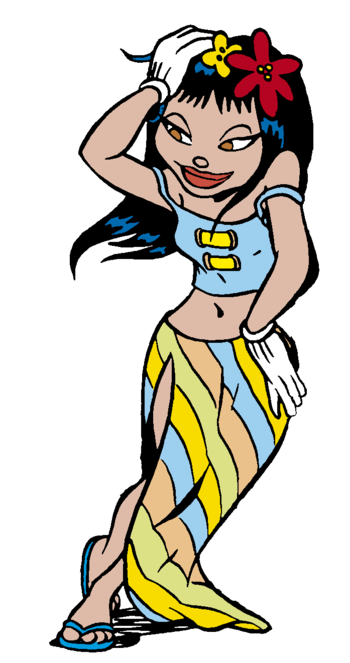
An international jewel thief from Bhummah. She is merciless, but does have a soft spot for Mickey for helping her out a number of times.
- Anti-Villain: Has some aspects of this. In her second appearance, she saves the world from destruction but gets away with an expensive ancient necklace she had her sights on regardless of the attached prophecy.
- Bare Midriffs Are Feminine: She often wears midriff-baring clothes, indicating her seductive Femme Fatale personality.
- Classy Cat-Burglar: A slightly more down to earth version, but one all the same.
- Dragon Lady: Literally called this by Mickey during their first encounter. She's a South-East Asian variant of the trope.
- Humanoid Female Animal: Lotus Blossom is a dogface in her first appearance, with a subtle snout and prominent button nose. Her appearances thereafter depict her as pretty much a human.
- Femme Fatale: She has genuine affection for Mickey, whom she calls "Big Ears", but even he isn't safe from her deception.
- Pirate Girl: In her first appearance. She hasn't done anything pirate-y after her crew got arrested.
- Race Lift: In her first appearance, Lotus Blossom looks South East Asian and Bhummah is presumably named after Burma, better known as Myanmar. In all her subsequent appearances, her skin is lighter and her outfit more mainland-ish, which makes her look East Asian.
- Villains Never Lie: Mickey's first encounter with Lotus Blossom ends with him learning that literally nothing of what she told him is true. The gist of Lotus Blossom's MO is to lie, lie, and lie some more until the presumption she can't solely be lying makes her believable. The only way to get past the lies is to carefully consider how what she says would benefit her and what the consequences of not believing her could be.
Gangsters
Mr. Slicker

Mr. Slicker is a man of wealth and standing, but also the leader of a gang. He used his criminal influence to manipulate Minnie into accepting his marriage proposal.
- Expy: Combined with Composite Character and Decomposite Character. "Mr. Slicker and the Egg Robbers" is a Gottfredson story from 1930 and the first to introduce a "Mortimer-esque" character: Mr. Slicker. Then in January of 1936 Gottfredson was involved with "Mickey's Rival", the comic that introduced Mortimer Mouse and was followed with an animated version in June. Lastly, 1941 saw the publication of "Love Trouble", scripted and sketched by Gottfredson. This comic debuted a third "Mortimer-esque" character: Montmorency Rodent. The likeness between the three is obvious, to the point one scene in "Love Trouble" appears set up solely so Goofy could say "Boy, I'll bet y' showed that slicker, Monty, up! Heard yuh played some kinda egg trick on 'im!" which evokes "Mr. Slicker and the Egg Robbers". However, Gottfredson treated them as separate characters because each of them had to be introduced to Mickey in their debut comics. Translations and later comics to feature these characters often differ in approach and present the three as the same or interchangeable. "Mortimer Mouse" is considered the default identity.
- I Have You Now, My Pretty: Among the many crooks that pulled this on Minnie, Slicker is notable for being the only one not to use brute force. This isn't to his credit, because his manipulations within the supposed safety of her home carry a level of insidiousness the others can't lay claim to. After she'd rejected him, he first had his gang steal the eggs from the farm of Minnie's parents to put them in a tight spot financially. With a little bit of talk, he convinced Minnie's desperate father to talk with her about the marriage proposal. To cut off any alternatives, he had his gang next rob the bank where Minnie had deposited the money she'd been gifted by Mortimer Mouse and any of her friends had their money too. Fate worked twice in his favor when Mortimer Mouse was away on business and could not be contacted and when he could frame Mickey for stealing the eggs (and by extension the bank robbery). While Minnie knew Mickey to be innocent and working to uncover the truth, time worked against her and she accepted the marriage proposal out of filial piety. Mickey could only stop the wedding at the last moment.
- No Honor Among Thieves: Although technically not outright stated, everything pointed at Slicker trying to run off with all the money his gang had stolen. Possibly, he intended to frame them as Mickey's gang. Mickey used Slicker's reluctance to hand over the trio's share of the loot to get their help in stopping the wedding.
- Rich Suitor, Poor Suitor: Slicker is rich, although if any of his wealth is legally obtained is unknown, while Mickey is poor in comparison.
Lucius Lamb
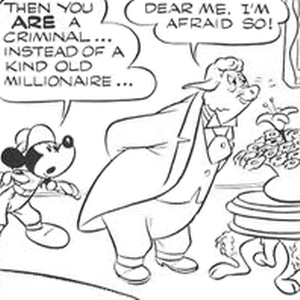
A softhearted criminal mastermind who operates on a national level and poses as a philanthropist. Among his employees are his butler Bludgins, the Tattooed Man, and a supposedly grandmother-grandson duo of which the boy is named Wilbur.
- Affably Evil: He makes Mickey and Eega Beeva milkshakes as he explains his scheme, offers them a job in his organization, cries when they refuse and he therefore has to kill them, and lets them pick the method of their murder from a menu.
- Death by Materialism: Not death, but nearly if not for the protagonists saving him. The final confrontation takes place in Lamb's Treasure Room and he can't swim. When trying to kill Mickey, he falls down in an 80 ft. pit of silver dollars and slowly sinks away until Mickey grabs his sleeve.
- Photo Op with the Dog: The photos of his vist to the orphanage come in just as Mickey and Eega Beeva catch on to him.
- Wealthy Philanthropist: Type Villain with Good Publicity.
- Wicked Cultured: He paints-sketches his schemes.
- A Wolf in Sheep's Clothing: As one may gather from the name, Lucius is a sheep. A criminal sheep pretending not to be a criminal.
Katherine Krisp

A possible gangleader and Gold Digger who closed in on Mickey during his time as a financier. Her right-hand man is Spiggins; it's possible everyone participating in her scheme is in her employ, but equally so he's her only henchman.
- Death by Materialism: Coupled with Taken for Granite. Despite being warned by the original owner of the Midas Ring not to put it on, Krisp does so, greedy for riches to come her way. Instead, she gets turned to gold (for putting it on "the forbidden finger", whether that refers to a specific digit or her greedy ones in general). On Mickey's request, the original owner uses his powers to change her back to normal.
- The Glasses Gotta Go: Krisp wears horn-rimmed glasses by default, but the one time she needed to look stunning to get Minnie to assume Mickey was cheating on her, she took them off.
- Gold Digger: Far from the usual, though. Krisp's exact plan before learning about the Ring of Midas is not made clear, but it involved isolating Mickey from his acquaintances, presenting herself as a romantic interest when Minnie comes in search of him, taking control of his life softened up with mild flirting, and so on. Given her willingness to kill for the ring, she also has Black Widow qualities.
- In-Series Nickname: Overlaps with No Name Given. Spiggins calls her "Millie" when objecting to his involvement in murder. The significance of this name is not explained. It might be a nickname, it might be "Katherine Krisp" is a fake name.
- The Jeeves: Spiggins is this to Krisp, but pretends to be to Mickey.
- Murder Is the Best Solution: Once Krisp learns of the Ring of Midas, she makes her designs on it. When Mickey elaborates he can't get it off, her immediate solution is murder to attain it, despite Mickey's eager cooperation in any harmfree approach to part with his ring. Spiggins at first protests because he's not comfortable with murder, but having a gun pointed at him works to remind him of his loyalties.
- Renaissance Man: As per her credentials: Doctor of Philosophy, Women's Discus Throw Champion, Test Pilot - Jet Aircraft, Intercollegiate Tennis Champion, First Prize; Paris Exposition; Cooking, Doctor of Law, Beauty Contest Winner; Miss Dish of 1952. Krisp wisely left off whatever netted her four semesters in jail.
Big Ben
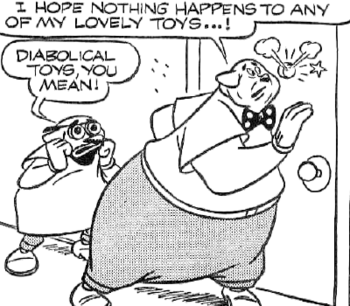
Big Ben, full name Benton E. Benton, is the leader of gang that lures in children to corrupt them and use as inconspicuous and disposable henchmen. Doctor Squeemish is his right-hand man who selects children for the "Real Goners" gang.
- The Fagin: Ben's organization lures children to his adult-free playground with the intent to make them his henchmen. He uses bribes and threats to keep them from telling their parents what's going on.
- The Family That Slays Together: Big Ben's full nickname is Big Ben III. Big Ben I and Big Ben II presumably are his grandfather and father. Big Ben 4 presumably is his son and appears to be in college. All four are wanted crooks.
- Funetik Aksent: Doctor Squeemish has a German accent and an odd habit of exchanging "b"s for "p"s and vice versa. This leads to him introducing his boss as "Pig Pen" instead of "Big Ben".
- Herr Doktor: Doctor Squeemish.
- I Have Your Wife: Son, as it would be. Some years ago, Ben's gang kidnapped Dexter de Longrine, son of the immensely wealthy Geoffrey and Lucia de Longrine. Lucia, a widow at that time, was forced to periodically send money to ensure Dexter's safety. Dexter, meanwhile, was being treated as any other child member of the gang, if a tad less disposable. Mother and son are reunited when the organization is dismantled.
- Killer Teddy Bear: Life-sized dolls, for the most part. There's several of them, only two of which named: Yoho, a clown, and Bubblehead, an alien. There's also a rag doll, a soldier, a jack-in-the-box, a pirate, a cowboy, a Carmen Miranda look-alike, and a swami. Although Mickey defeated the lot of them, they are apparently vicious. Doctor Squeemish objected to letting the dolls deal with the spy because he considered that too cruel.
- Large and in Charge: Overlaps with Fat Bastard and pretend-Big Fun. Big Ben is huge, the boss, and arguably one of the most despicable crooks Mickey ever dealt with. One of the reasons he gets children to trust him is because he exploits his appearance to create the image of a big child.
- Pleasure Island: Big Ben is the owner of a playground that already spells doom with the signs at the gate: "all children invited" and "no grownups permitted". The various stands on the playground offer gifts like cigars and money, and there's a shooting gallery using real bullets with the cutouts resembling various authority figures.
- Psychopathic Manchild: Ultimately, Big Ben knows knows his size and brain give him authority over the children he's captured, but he genuinely likes the simplicity of childhood. He's introduced while playing with a toy train, his collection of custom-made toys is killer, and he's implied to have a Sweet Tooth.
- Supreme Chef: At least, he can create banana splits worthy to be called masterpieces. It is hinted to overlap with Lethal Eatery as his creations might be drugged with one substance of another if the suspicious wink is anything to go by, but this is not followed up on.
- Wicked Toymaker: Whoever manufactured Big Ben's toys, for which the best guess based on the information given is Big Ben himself. He's at least the user.
Dangerous Dan McBoo and Idgit the Midget

A pair of criminals. They are often involved with Emil Eagle, whether as his henchmen or as his rivals.
- Affectionate Nickname: As seen in "The Mystery Monster from Smoggy Bog" and "The Bargain Hunter", Idgit occasionally refers to Dan as "Danny boy".
- Big, Thin, Short Trio: Form this with Loner. Loner is the thin one, Dan the big one, and Idgit the short one.
- Expy: Their debut comic, "The Treasure of Oomba Loomba", is a remake of "In Search of Jungle Treasure", which stars Pete and Eli Squinch in the role of antagonists. The two sets of villains are little alike, but fact is Dan and Idgit have their origins with Pete and Eli.
- Cigar Chomper: Idgit used to be this, but with attitudes towards smoking having changed he hasn't had a cigar in years.
- Feathered Fiend: Dan commanded a falcon named Hector in "The Falcon's Folly". It's implied to have been given or lent to him by Emil Eagle. "Message in a Nutshell" sees them being the owners of a semi-sapient myna named Heathcliff, who assists them in their scheme. Minnie confiscates him at the end of the story.
- Heterosexual Life-Partners: Overlaps with Big Guy, Little Guy. If you encounter one, the other is generally not too far away. You're slightly more likely to see Idgit in a solo appearance, but these occasions are rare.
- Master of Disguise: Overlaps with respectively Disguised in Drag and Adults Dressed as Children. Due to his size, Idgit can reasonably pull off a baby or child disguise. With Dan dressing up as a woman, they have perfected a "mother and child" routine they can pull off whenever useful as they did in "The Treasure of Oomba Loomba" and "The Diabolical Disguise". Then there's also that time Idgit and Emil Eagle dressed up as elves and pretended to work for Santa Claus in "Invaders from Hootowl Hollow".
- No Honor Among Thieves: Only once does either of the two betray the other: in "Message in a Nutshell", Idgit tricks Dan into locking himself out of the helicopter filled with diamonds so he can fly off with a larger amount. Could be considered the exception that proves the rule, but there aren't any other scenarios in which a choice has to be made.
- Pint-Sized Powerhouse: Despite Idgit's small size, he's tough as nails. Take a look at his response upon being (counter)threatened in "The Red Wasp Mystery":Idgit: "Okay! Go ahead — if you think you're big enough!"
- Remember the New Guy?: On account of debuting as the replacement of Pete and Eli Squinch in a remake of "In Search of Jungle Treasure". The other two had several stories of buildup before their roles in "In Search of Jungle Treasure". Dan and Idget had not.
- Rogues' Gallery Transplant: They have faced the Red Bat, Fethry Duck's superhero self, several times.
- Shorter Means Smarter: Dan and Idgit are often portrayed as equal in intelligence and ambition, but in those rare cases one of them is portrayed as more intelligent and ambitious, it's Idgit. Furthermore, as noted above, Dan never operates without Idgit, but Idgit's on occasion operated without Dan by teaming up with Emil Eagle or Pete.
- Spell My Name With An S: Some comics, like "The Trail of the Doodlebugs" and "Message in a Nutshell", spell "Idgit" as "Idjit".
- Toothy Issue: A detail of Dan whenever Paul Murry draws him - and he was the first to do so - is that he's either got a tooth (or two) missing or he has a notable gap. It's located on the upper jaw, usually behind the incisors, but the spot may also be one further to the front or one further to the back. He either has this gap on both sides or he has it on one and it's just drawn on whichever side is visible in a given panel.
Loner

A criminal who's a high-ranking henchmen and friend of Dan and Idgit.
- Big, Thin, Short Trio: Forms this with Dan and Idgit. Loner is the thin one, Dan the big one, and Idgit the short one.
- Death Trap: He's got a few of these, including a The Walls Are Closing In, which he used to get rid of the Red Wasp and Mickey-disguised-as-the-Red-Wasp.
- Gadgeteer Genius: All his equipment is his own creation. He even has a rocket platform!
- The Hermit: He's social enough, but his installations are built well outside of the city (in a mountain/forest area) and he probably doesn't carry the name "Loner" for nothing.
"Cheshire" Charlie
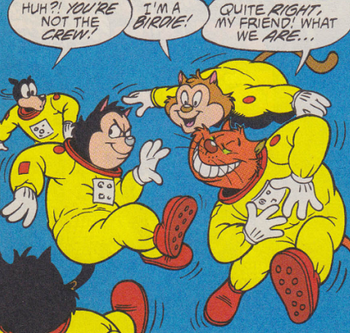
A perpetually smiling gangster with perfect hearing and his own internationally operating gang of cats. One of them, Tubby, is his nephew. The other two are identical black cats of which one is named Eddie and the other's name is not given.
- Affectionate Parody: Of the Cheshire Cat.
- Cats Are Mean: Other than Mickey, all good characters in his one story are dogs. Not even dogfaces, straight-up dogs.
- Even Evil Has Loved Ones: "Tubby, if you weren't my nephew..."
- Evil Redhead: His fur is red.
- Perpetual Smiler: With the looks of a Cheshire Cat Grin.
- Super-Senses: Not exactly "super", but his hearing is excellent. Nothing the protagonists whisper at each other goes unnoticed by him and he mockingly reminds them of that when they forget.
Krankle Gorb and co.
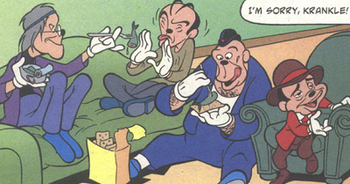
A quartet of gangsters. The small one is the leader, Krankle Gorb, the big one is Bod, the one with glasses is Od, and the skinny one is Cod.
- Anti-Villain: They tried to be this for a short time on "Mookie"'s suggestion. The plan was to rob Obnoxious Fumes Inc., a company widely known for its corrupt activities, but "Mookie"'s refusal to kill put an end to that.
- Beatnik: Od is one.
- Color-Coded Characters: Krankle wears red, Bod sports blue, Od dresses in purple, and Cod goes with green.
- The Corrupter: The moment Krankle saw an opening (Mickey's loss of memory), he started telling him that he was a member of his gang and gave him the new name "Mookie" to disassociate him from his true self while still sounding familiar. Twisting the truths he knew from reading the paper on Mickey's adventures, for a good while he managed to get Mickey on his side, but he ultimately couldn't break through Mickey's conscience.
- Gentle Giant: Bod may be a crook, but his feelings are easily hurt, like when the news reports demeaningly on the group.
- Mister Big: Krankle is the smallest of the four and the leader.
- Supervillain Lair: An abandoned underground mansion in the forest that was built by an eccentric millionaire who hated the sun. Not bad!
- Verbal Tic: Bod rarely says more than "b'duh!".
- Villain Team-Up: The team joined forces with Inky Black Inc. in "Gliquid". It was a dud, as they couldn't think of a single use for gliquid to make a profit with.
Hang Tung
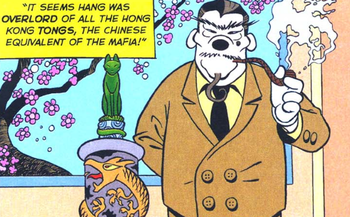
The former leader of all the tongs in China. He owed his status to the possession of the Jade Cat, to which all tong leaders had sworn loyalty. While still a powerful man, with the tongs back at one another's throats his influence has been greatly diminished.
- The Don: The "Don" of all "Dons" at one point.
- Good Smoking, Evil Smoking: Evil variant.
- #1 Dime: The Jade Cat.
- Overlord Jr.: He inherited his power from his grandfather, who established the Jade Cat as a symbol of loyalty in the first place.
- Yellow Peril: Hang Tung is noted to only operate in his own country, but the hunt for the Jade Cat has him send his men to America to steal it (mind that it was stolen from him in the first place) and his opposition includes an American (Mickey) and a presumably Eastern European (Katarina).
Spies
Trigger Hawkes

An ex-officer from the Secret Service who's fallen in with the spy scene.
- The Bus Came Back: Trigger was only used once by Gottfredson and did not appear in another story until 2000. For now, his last appearance was in 2005.
- Face–Heel Turn: Used to be with the secret service, then figured it was more profitable to run off with their secrets and sell them. He's still got a few people sore at him for this as per "Why Spy?".
- No Honor Among Thieves: Pete deserted him to save his own hide. Trigger can live with it because he stole the blueprints prior because he didn't trust Pete with them. This leaves Pete wanted with nothing gained from his crime. They appear to be back on half-decent terms in "History Re-Petes Itself".
- Oral Fixation: Of the Smoking Is Cool variety with a cigarette always hanging loosely from his mouth. Only in his first appearance.
- Perpetual Expression: In his first appearance, Trigger has a moody-bored face that he defaults to when he is without specific emotion.
- Sharp-Dressed Man: Trigger's default attire is a suit with hat.
Greta Korp
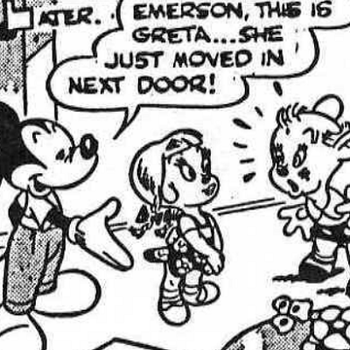
A child spy with a high success rate.
- Child Prodigy: In terms of spying, anyway. Emerson refers to her as "famous" and "notorious".
- Enfant Terrible: With how terrified Emerson is of her, she is this, although any showmanship of her reputation isn't provided.
- Hidden Villain: The image may or may not actually be of Greta Korp. When Emerson sees her, he's on edge for fear of spies and promptly identifies the girl as Greta Korp. Whether he was right or not is not given, nor is, if he's wrong, whether the name alone caused the mixup or the girl also looks like Greta Korp.
- A Nazi by Any Other Name: Unlike villains in the early 40s, Greta is not explicitly identified as a Nazi. However, it was 1946, meaning the only two types of spies that existed in American fiction were Germans and Russians, and with a name like "Greta Korp" she has to have German roots.
The Rhyming Man

A criminal and master spy (from an unnamed foreign power) who always speaks in rhymes.
- The Bus Came Back: The Rhyming Man was only used once by Walsh, but he became a semi-regular in the Italian comics starting 1994.
- Catchphrase: Somewhat. In his first story, the Rhyming Man's first rhyme is "And now there comes upon the scene, a master spy, well bred but mean". The same rhyme is used in the English translation of the Italian story "The World to Come" when the Rhyming Man reveals his involvement to Mickey.
- Chest of Medals: The Rhyming Man is really proud of his uniform and all the medals he gets to wear on it. All earned fair and square, minus the part where he sometimes kills a colleague or underling so as not to have to share the glory. Take note, he doesn't take undeserved credit and indeed will time his murders to avoid having another do what he could do himself. It comes back to bite him in his first story when he falls into the sea and the weight of his numerous medals drags him down.
- Dirty Communist: In his origial appearance. He was never specifically said to be from Russia, or a Communist, but he did invoke a few Red Scare moments, especially with his long rhyming speeches about the glories of his own country, which was a foreign superpower with vastly superior technology.
- The Dreaded: Feared by everyone who knows him. Even Mickey would rather deal with Phantom Blot rather than this guy.
- Green Thumb: He loves gardening, both for the activity and plants themselves and to create killer plants to hand adversaries too. His pride and joy is the strangler tree.
- Knight of Cerebus: Him being the villain of the story raises the stakes considerable, considering he's one of Mickey's few enemies with no qualms with murder.
- Master of Disguise: As long as he doesn't speak, he's quite good at becoming unrecognizable.
- No Honor Among Thieves: In addition to the whole killing colleagues thing, the Rhyming Man had this to say in his first story about his employers:Rhyming Man: "My friends, I fear, are no great loss — they'll get a lovely double cross!"
- No Name Given: He's only ever referred to as the Rhyming Man.
- Rhymes on a Dime: Hey, he is the "Rhyming Man".
- Take Over the World: Even in his first home country-loving appearance, this was an option of interest to him.
- Talking to Themself: A conditional case of Split Personality. When the Rhyming Man needs advice, he only considers himself smart enough to seek help from. So, he has his own room with two mirrors and each mirror's reflection is someone he can talk to. The two reflections are in competition for authority, but are similar in logic and mannerisms. Notably, neither of the reflections speak in rhyme.
- You Have Outlived Your Usefulness: The Rhyming Man gave two of his comrades a Neck Snap after he was done with them in his original appearance.
Aygotcha

Head of the (Russian) Secret Police and by her own claim the most feared woman in Europe.
- The Baroness: The Sexpot type. Pretty, flirtatious (Eega falls for it), devoted to her country, ready to kill her own soldiers if that's convenient, and she made no secret of her hope she'd be the one to kill them once they'd be of use no longer.
- Dirty Communist: Muuuuuch less subtle than the Rhyming Man. Her debut comic stops short of calling the Soviet Union by name, although the Iron Curtain is the topic of one gag. What with Mickey and Eega actually being brought to Russia as opposed to preventing their plane from reaching its destination in "The Atombrella and the Rhyming Man", the Red Scare moments are a near-constant during the middle section of "The Moook Treasure".
- Hijacked by Ganon: Aygotcha enters the story at the midway point to become an Obviously Evil guide to the protagonists they cannot refuse. All kinds of scenarios lie open as the trio makes its way into Commie Land until they step into her superior's office. Said superior is Pete. He has her sent to a concentration camp just because he can and that's the last heard of Aygotcha. Pete takes over for the final third of the story.
- Mysterious Veil: Mickey and Eega Beeva received the warning: "Beware the woman veiled in blue..." while in Egypt. They find out what it means when they're captured by Aygotcha in Turkey. She only wears the veil for four strips, though.
- No Honor Among Thieves: After having successfully brought Mickey and Eega Beeva to Pete, who also wants to find the Moook Treasure, Pete thanks her and promises her a reward. After she has left his office, he calls security to arrest her and send her to a concentration camp. He explains to Mickey and Eega that this kind of management keeps his spies on their toes.
- Punny Name: "Aygotcha" is an alternative spelling of "I've got you".
- Wingding Eyes: When Aygotcha insists that she is actually a sweet person, her pupils become skulls.
"One", "Two", and "Three"

A set of five crooks, "One", "Two", "Three", the Professor, and the Captain who tried to take over the world with a new type of robot.
- Coat, Hat, Mask: "Two" and "Three" wear the full set.
- Color-Coded Characters: In the original print, "Two" and "Three" are distinguished by the color of their coats too. "Two" wears red, "Three" wears green.
- Einstein Hair: Notwithstanding the large bald spot on top, this goes for the Professor.
- High-Class Glass: On "One"'s right eye.
- Mecha-Mooks: The quintet tried to create these. "One", "Two", and "Three" arranged most of the initial production, while the Professor created a mechanical heart to operate them. The heart could be made from old tin cans, so resource-efficient.
- No Name Given: As per the intro, they only go by titles and codenames. Confusingly, the codenames of "Two" and "Three" sometimes get switched around, but "Two" is the one with the fedora and "Three" the one with the flat cap.
- Noodle Incident: "One" twice tells "Two" not to get trigger-happy, mentioning how that got them into trouble in Casablanca and Calcutta.
- The Professor: He's literally only referred to as the Professor.
- Shout-Out: The Professor's face and body language are similar to those of the March Hare of Alice in Wonderland, while his hair is more like the Mad Hatter's. The Disney movie came out in July of 1951, while "The Mystery of the Robot Army!" is from October of that same year.
- Sissy Villain: "One", what with his reluctance to commit violence and long cigarette holder.
- The Smart Guy: "One". After losing track of Mickey, "Two" even assures "Three" that they don't need to fear the police because "One" can outsmart them any day.
Rich Hogg
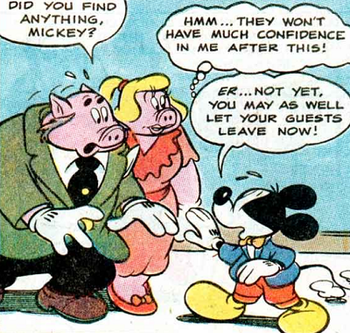
A spy who was to take a record with drought songs from India to his home and pass it on to a colleague later, along with the indestructible nail that was the only means to make the secret message carved into the record available.
- Disguised in Drag: Technically, Hogg spent much of the story pretending to be a woman.
- Happily Married: Seemed to be this before Mickey exposed him as a spy.
- Multi-Armed and Dangerous: While in his Kali costume, Hogg has four working arms. How the extra two work is never explained, as his suit is drawn as mere cloth when he's not in it.
- "Scooby-Doo" Hoax: To find the missing record with the secret message among 17 regular records that had already all been sold, Hogg fake-steals the nail of Kali with seven witnesses in the other room to make it look like he's Kali's initial victim. Then he dresses up every night as Kali to frighten people so he can trespass in peace. Having a list of each buyer, he visits them one by one and uses the nail on each record, creating a horrible and terrifying noise whenever he's got the wrong record. He then carves "bah" into one of the walls and leaves a Kali doll underneath before leaving.
- Shout-Out: "Kali's Nail" is a product of admiration for "Mickey Mouse Outwits the Phantom Blot" with a hint of "The Gleam". As such, Rich Hogg is a shout-out to the Phantom Blot and to a lesser extent the Gleam.
The Red Bat
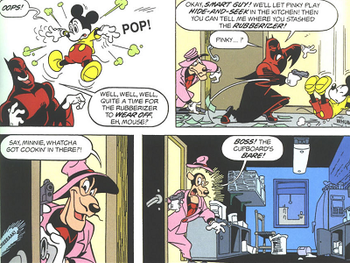
A criminal dresses up in a red sheet with batwing sleeves. Not to be confused with the superhero identity of Fethry Duck. He has a gangster-style henchman named Pinky.
- The Faceless: The face underneath the sheet is not shown.
- Genius Bruiser: Or Badass Bookworm, depending on how you rate the Red Bat's ability to throw fists. The reason he learned about Static's rubberizer is because he studies science journals.
- Good Wings, Evil Wings: With Good Animals, Evil Animals on the whole bat dress-up.
- No Name Given: He's only ever referred to as the Red Bat. Pinky could go either way on being his civilian name or an alias.
- Real Men Wear Pink: Pinky, as dangerous and competent a henchman as one can expect from a Mickey Mouse comic, dresses in pink.
- Red and Black and Evil All Over: Technically only red (and white gloves), but the shadowing provides him with the black.
- Remember the New Guy?: Mickey says he's gone toe-to-toe with the Red Bat before in "Plastic Mickey" even though it's his first (and only) appearance.
- Shout-Out: Just look at this guy and try to not think "That you, Phantom Blot?".
Evil businessfolk
Big McCall and Little Echo
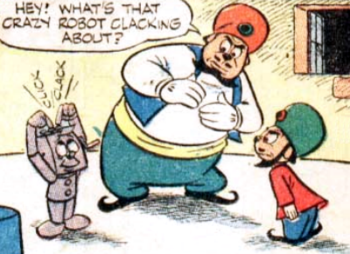
A duo of crooks that runs Futures, Inc., a fortune-telling establishment. When operating the store, Big McCall goes by the moniker Great Elmer.
- Big Guy, Little Guy: McCall is the big one and Echo the little one. They're one of the rare cases where the big one is the mastermind. However, Echo is the more sensible one.
- Shoot the Messenger: When Charlie, whom they had abducted because of his futuresight, predicts to the second when they'll be arrested just when they thought they were safe, Big McCall throws him out of the 4th floor window in an attempt to thwart the future by destroying its messenger. It doesn't work.
- Supervillain Lair: Months prior to the events of "Goofy's Mechanical Wizard", Big McCall had fixed himself up a luxurious hideout in the silo of a deserted farm house. 1st floor is the farm house itself, 2nd floor weapon storage, 3rd floor the kitchen, and 4th floor the living quarters. Little Echo was suitably impressed.
- Theme Naming: "Big McCall" and "Little Echo" make use of "big" vs "little" and on the McCall/Echo side incorporate sound.
- Verbal Tic: As can be gathered from his name, Little Echo repeats the last bit of his final sentence, usually twice.
J. "Bunky" Pettigreed

A rich pig looking to get even richer by becoming the owner of the world's monuments. He hired Professor Doublecross to accomplish this and did his best to keep the heads from fighting.
- Corrupt Corporate Executive: He knows monopolies make the most money, hence why he wants a monopoly on the world's monuments.
- Eyes Always Shut: Shock and interrogation are the only two occasions where he's opened one of them.
- Good Smoking, Evil Smoking: Evil smoking is in effect with his ever-present cigar. His debut panel even has him casually blowing a big cloud of smoke as if he owns the place. Which, okay, he does, but it's still an unnecessary sign of self-importance.
- Meaningful Name: "Petty", "Greed", "Pedigree".
- Monumental Theft: He aims to steal the world's monuments so he can build an exclusive theme park.
Ilary Queen

A writer of mystery novels who commits her own crimes to take inspiration for her stories from.
- Broken Pedestal: Minnie was a big fan of Ilary until the latter flirted with Mickey during his investigation into a series of robberies. Realizing Ilary was the crook behind it all permanently got her kicked out of Minnie's esteem.
- Fiery Redhead: Overlaps with Tomboyish Ponytail and Spy Catsuit. Ilary has red hair done up in a ponytail regardless if she's in civilian guise or in her catsuit. In the latter case, the ponytail stands out due to its contrast with the suit.
- Phantom Thief: Of the kind that has Sticky Fingers. Ilary only goes for well-guarded loot for the thrill of it and for her writing career.
- Shout-Out: Ilary is named after Ellery Queen, the protagonist of a long series of mystery novels as well as the pen name of its writers.
Fatima
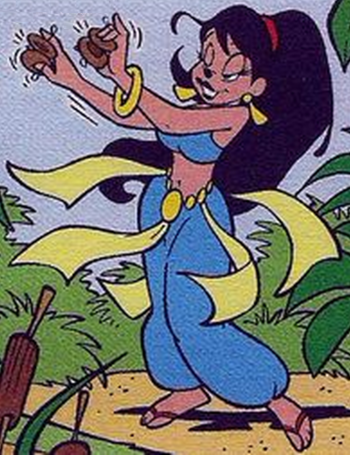
A ruthless businesswoman who sought to turn a valley into a luxury vacation destination. She has a cobra for pet.
- Bedlah Babe: She can be a belly dancer if it helps lure someone into a false sense of security, but for the most part she travels the desert, which this kind of outfit is not suitable for.
- Corrupt Corporate Executive: She stole Doc Static's oasis-creating machine to flood a populated valley. She'd take over thereafter, using the machine to create an inviting paradise with the finest of hotels that'd be staffed with the valley's survivors. Fortunately, Mickey stopped her plan right after the stealing part.
- Snakes Are Sinister: Fatima's got a pet cobra, which basically classifies her as Obviously Evil.
Evil performers
Ambrose Bones

A thin man who stole food from the circus and got humiliated in the aftermath. He sought revenge for that.
- Big Eater: Like the historical skeleton men, Ambrose can eat a lot without gaining any weight. He does so aplenty, consuming food meant for multiple people all by himself.
- Lean and Mean: He used to be just lean. Then he got in a fight with the circus manager and became mean.
- Punny Name: He's a skeleton man and named "Bones".
- Revenge by Proxy: The circus manager offered him a job when he thought Ambrose was a magician. He was not, and the only reason he could get to the food in the ice box was because there was a hole in it on top. Irate at being robbed and deceived, the circus manager kicked him out. Ambrose swore revenge over his treatment and set to work achieving it. Not by targeting the circus manager himself; no, his target was the entire circus, by means of sabotaging and abducting its star, Mademoiselle Maltese. She had nothing to do whatsoever with the altercation prior.
- Vehicular Sabotage: A horse may not entirely qualify as a vehicle, but there's the same thought behind it. Ambrose tried to take out Mademoiselle Maltese through Charlie thrice: once by soaping up his back so he was to slippery for Maltese to stand on, once by putting roller skates under his hooves, and once by feeding him buckshot disguised as caviar.
Mr. Meanie
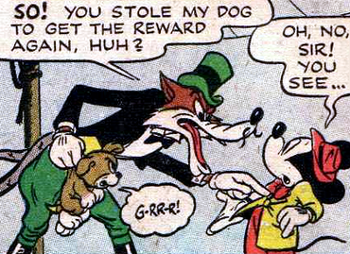
The owner of Meanie's Circus and former owner of Tagalong.
- Bad People Abuse Animals: Tagalong's ability to whistle has something to do with his diet of birdseed. Mr. Meanie knows the dog hates it and even uses doubling his meals as a threat to get him to perform.
- Cunning Like a Fox: He's a villainous fox whose craftiness is only hampered by his impulsiveness.
- Judgment of Solomon: When Tagalong refuses to whistle for the circus audience after having spent some time with Mickey, Meanie starts a case against him claiming Mickey abused his dog so badly he's too traumatized to perform. He also claims Mickey stole Tagalong, while Mickey insists the dog followed him home and was treated well. To get to the truth of the matter, the judge has Mr. Meanie and Mickey each stand on a side and Taglong released in the middle on the assumption the dog will go to the person he's got the most affection for. Things don't look good for Mickey when Tagalong hurries to Meanie, but as it turns out that's only to blow him a good riddance raspberry. The dog then hurries to Mickey, who is subsequently relieved of all charges.
- One-Steve Limit: Averted with the existence of Meanie Markham, although in his case it's his forename while in Mr. Meanie's case it's his surname. No Name Given adds further confusion as Mr. Meanie has no forename to help distinguish the two.
- Repulsive Ringmaster: From his job, his looks complete with Dastardly Whiplash, his abuse of Tagalong, and his aggression towards Mickey, he definitely fits the trope.
Miklos
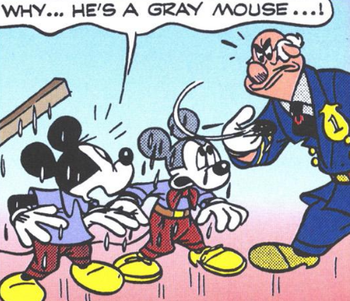
A cunning Master of Disguise who sometimes tries to steal Mickey's life, committing heists and leaving the other to take the fall.
- Criminal Doppelgänger: He is a crook who, aside from having gray fur, looks exactly like Mickey Mouse.
- Curb-Stomp Battle: In "Mickey and the Grey Scourge" he fought Pete, the fight consisting in Miklos throwing Pete around until he decided to listen. Later in the same story he fought Mickey, and quickly stunned him and was about to beat him to death when the police barged in.
- Identical Stranger: He looks really similar to Mickey, the only difference being that he has grey fur.
- Karma Houdini: While defeated, he's quite good at escaping:
- In "Mickey's Dangerous Double" he disappears as soon as nobody's looking at him for a split second. Made more egregious because O'Hara was holding his arm when he did it.
- In "Mickey and the Grey Scourge" he uses a smoke bomb to force the others to look away, and when the smoke disperds he's disappeared.
- Subverted in "Mickey and the 7 Boglins": after what he pulled you'd expect him to escape again, but when Miklos is unmasked O'Hara immediately handcuffs him, and there's always at least a cop looking at him.
- He's caught when he reappears in the "Gambaville" storyline, but quickly breaks out and at the end disappears thanks to a fire.
- Kick the Dog: In his first appearance he even stole candy from an infant in a stroller. Pluto's terrified response to Mickey when he finds him also suggests Miklos committed animal abuse.
- Kill and Replace: Miklos's plan for Mickey in his debut comic.
- Manipulative Bastard: What really makes him dangerous: he will manipulate people and their perspective until they believe that Mickey is a criminal, also planning for them to realize there's an imposter but believe that Mickey is. And in one occasion he managed to make Mickey himself fall for his rouse (admittedly, keeping Mickey drugged was a big help in that).
- Master of Disguise: In his first appearance he also disguised himself as chief O'Hara, and Mickey mistook him for the real deal until the fake O'Hara showed him some of his other disguises. Also, in the first story Mickey showed his patch of white fur that was normally covered up by his clothes, only for Miklos to show an identical one!
- Mirror Routine: Miklos pulls this on Mickey when they meet for the first time. Mickey only realizes a few seconds later he's not wearing a turtleneck.
- Not Me This Time: In the "Gambaville" miniseries Pete using a holographic disguise commits a series of crimes disguised first as Mortimer and then as Mickey, and then frames Miklos for it for having refused to join his new gang.
- O.O.C. Is Serious Business: In the last story of the "Gambaville" miniseries he asks for Mickey's help, even when there's enough bad blood between them that Mickey literally jumps and tries to beat him unconscious on sight. The sheer absurdity of the situation is enough for Mickey to stop trying to brain him and listen to his claims (that he thankfully had good evidence for).
- Spot the Imposter: In all his appearances, someone had to tell the difference between Mickey and him:
- In the first story, Pluto was out of commission, so his friends tried and failed to tell which one was the real deal until Miklos washable dye got wet;
- In "Mickey and the Grey Scourge", Mickey's friends failed again to tell the real deal. But this time Pluto was available to point out the real Mickey, at which point Mickey could ask for some water to wash away Miklos' dye;
- In "Mickey and the 7 Boglins" Pluto wasn't available, and Miklos had used unwashable dye on both himself and Mickey. Turns out, Minnie (who in the previous stories had been able to tell which one was the real Mickey but then doubted her own findings) had realized the switch and, to get confirmation, told Miklos that he, as Mickey, was supposed to have a tattoo declaring his love for her, so she asked which one had the tattoo... And promptly declared the Mickey with the tattoo as the imposter, as the real Mickey never had it but Miklos had hurriedly gone to get it.
- In one occasion he had the bad luck of stumbling into Ellsworth, who recognizes him the moment he calls Minnie "babe" (something Mickey would never do).
- Stage Magician: Used to be one before going evil.
M. Skoolik
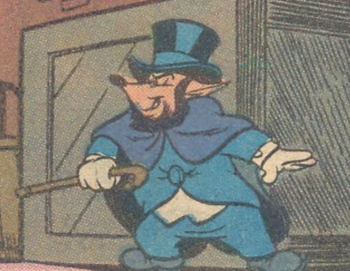
A stage magician who steals tricks from his colleagues.
- Funetik Aksent: It comes and goes. He starts with it, then drops it, then regains it, then drops it again in the final pages.
- The Napoleon: Notable compared to the tall Mar-Bul; Skoolik is barely a head taller than Mickey.
- Nobody Here but Us Statues: Skoolik pretends to be a dummy to avoid being detected by Goofy (and for a second by Mickey).
- No Name Given: He lacks a first name. The only thing known is that it starts with an "M".
- The Rival: To Mar-Bul, a fellow magician who does not go around spying on other magicians.
- Sore Loser: Upon defeat, he's gracious enough to promise Mar-Bul he'll leave him alone from now on, but he's less kind on Goofy. With another trick, he leaves the one who shocked him with three sources of water pouring out over him.
- Stage Magician: It's his occupation. He's presumably talented if he's worthy of being called a rvial by Mar-Bul. Based on his final trick on Goofy, his skill moves to Magicians Are Wizards.
- Sword Cane: He tried to puncture Mickey with it, but Goofy accidentally shocked him through it.
Sam Van Go
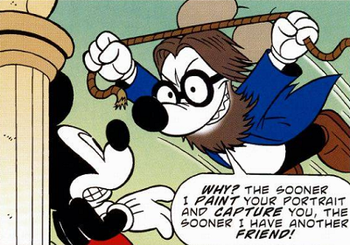
A conceited painter with little talent and even fewer friends.
- Companion Cube: It is hinted that without living paintings, Van Go projects personality on his regular art pieces. During creative therapy in jail, he weaves a basket he names Jenny and starts talking to.
- Friendless Background: He considers his paintings/prisoners his friends, to the point he trusts them to be honest which way the one person who can free them went. He doesn't have any normal friends (anymore) because he refuses to stop speaking about himself and his talent.
- Motor Mouth: He just won't stop talking (about himself). It even drives his fellow prisoners bonkers.
- Phantom-Zone Picture: Due to his magic paintpot, Van Go was able to lock people into paintings by drawing their outline. They could only speak and move withing the paintings at night.
- Power Crutch: Van Go got his painterpot from his third cousin, a magician. It's the thing that allows him to lock people into paintings, but some talent for depicting them is required to make use of it.
- Shout-Out: Sam Van Go is named after Vincent Van Gogh.
- Terms of Endangerment: He refers to his paintings/prisoners as "my lovelies".
Charlie "The Magnificent" Doublejoke
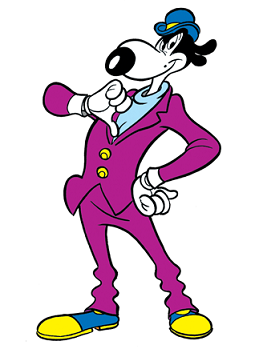
Once one of Mickey's elementary schoolmates, who was kicked out after a brawl with the mouse. Now a criminal inventor, he's fond of using seemingly innocent toys to carry out his criminal plans.
- Attention Whore: While he likes the money, he always makes sure everyone would notice him and that he's considered a great hero. In his first appearence especially he wanted the attention of Mickey who he still blames for being kicked out of elementary school.
- Brown Note: A synthetic joke that makes everyone who hears it laugh... and laugh... and laugh some more as they treat everything as a funny joke. This includes Charlie plundering the entirety of Mouseton, but not, thankfully, an IRS letter demanding a large amount of back-taxes (fake letters are how the victims of the joke are cured).
- The Bully: Doublejoke was one as a child under the guise of pulling pranks. His friendship with Mickey ended when the latter disagreed that stealing glasses qualifies as a prank.
- Evil Genius: He seems to be very intelligent, creating all kinds of gadgets and developing plans - sadly, he only uses his genius for evil schemes.
- Fake Ultimate Hero: In his first appearance he sets himself up as a new crimefighter in Mouseton, rivaling Amateur Sleuth Mickey Mouse on this regard and turning the latter into a Hero with Bad Publicity who noone trusts anymore. It of course is just an act staged for a big coup.
- Falsely Reformed Villain: He wasn't exactly a villain when Mickey last saw him on account of the both of them being little children at that time, but upon his return in Mickey's life as an adult he claims to no longer be the bully he once was because he took an example after Mickey. Cue the trope, it's all a lie to pull off a huge heist when everyone's guard is down.
- Gadgeteer Genius: He creates inventions to commit crimes.
- Giggling Villain: His signature laugh is more like a maniac giggle.
- Hoist by His Own Petard: More often than not he'll be defeated by his own inventions being used against him.
- Laughably Evil: A rather silly villain.
- The Magnificent: He refers to himself as "The Magnificent Doublejoke". In his first appearance he did seem to deserve the nickname by arresting many of the most dangerous criminals in Mouseton with embarrassing ease and pranks... Then it was revealed they were his accomplices for an enormous heist.
- Practically Joker: He's a purple wearing prankster, much like the Silver Age version of The Joker. His rivalry with Mickey Mouse, a well-known detective in his hometown also draws parallels to Joker's relationship with Batman.
- The Prankster: His Modus Operandi are overcomplicated pranks.
- Shout-Out: Doublejoke's original Italian first name is Vito. His English name, Charlie, appears to be a reference to Charlie Chaplin.
- Signature Laugh: "Wah-wah!"
- The Italian version is an absurd "Sguoz sguoz!".
- Unknown Rival: His first scheme was especially designed to get revenge on Mickey after all those years, blaming the latter for being kicked out of elementary school - Mickey, on the other hand, totally forgot that event and needed a refresher to get why Charly was targeting him. However, in his later appearances Mickey took him as a real enemy.
Evil hunters
Wiley Wildebeest

A big-game hunter who seeks the rarest preys to sell and boost his reputation. He's generally harmless to people unless they get in his way and he will hold a grudge for a long time. Also, "people" does not include aliens or individuals visibly from other dimensions.
- Back for the Finale: Wiley is the third new villain introduced in the Mickey Mouse Adventures series, starring in the fourth issue. He was brought back for a two-parter in the final issues, #17 and #18.
- A Dog Named "Cat": He's an anthropomorphic tiger, not a wildebeest.
- Egomaniac Hunter: He does sell his catches, but he takes a great deal of pride from exclusively targeting rare critters.
- Even Evil Has Standards: Do not accuse him of being a thief. He may force people to sell him stuff if he needs to, but he pays for the goods.
- Evil Gloating: The reason why he failed to get Mickey & co. stuck in the past.
- Evil Poacher: He'll do a lot to get a good catch.
- The Hunter Becomes the Hunted: Happens to him after messing with time so that dinosaurs become the dominant species in "The Future Ain't What It Used to Be!". He only teams up with Mickey to undo this fate.
Colonel Phineas Philcher and P. T. Cheatum
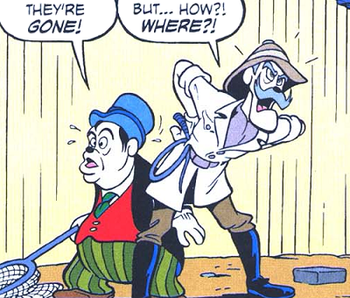
- Bad People Abuse Animals: They don't treat the animals they possess right. Well enough to keep them alive, but otherwise maximizing their profit is the main concern.
- Collector of the Strange: Shown in "Mythos Island: The Unicorn Horn" (Part 4). In lieu of live animals, the two also have a collection of artifacts to put on display that may or may not be fake. Their collection includes a fake unicorn horn (they had a real one only for a few hours), kryptonite, a bigfoot footprint, and a stuffed two-headed snake.
- Great White Hunter: Philcher literally calls himself this in "Free Weegie".
- Heterosexual Life-Partners: Philcher and Cheatum always operate together.
- The Hunter Becomes the Hunted: At the end of "Free Weegie", it's Philcher and Cheatum
- Repulsive Ringmaster: Between the two, this is Cheatum's role, but Philcher sometimes doubles for it too when he personally shows off the animals he's captured.
- Shout-Out: P. T. Cheatum is named after and indirectly based on P. T. Barnum, a 19th Century showman.
- Sycophantic Servant: Cheatum is not Philcher's servant, but his role in their setup is getting customers. When they're part of a story, they're part of an adventure and that's Philcher's territory, so Cheatum can come across as a mere sidekick. He is full of compliments for Philcher's hunting skills, even though Philcher always brushes it off as nothing or insults him for thinking of his achievements as impressive.
- Would Hurt a Child: They hurt Weegie. There's some ambiguity if they knew he was a child, but they certainly did not care to learn anything about their captive other than how to exploit him.
Saul the Slob
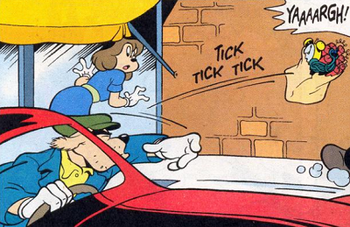
A hitman hired to kill Mickey.
- Eyes Always Closed: He's not in a lot of panels and never well in view, but it seems to be the case. The only moment his eyes are clearly open is when the police suddenly shows up.
- Fluffy the Terrible: "The Slob" doesn't sound very intimidating, now does it? The trick to it is that he's a hitman and that he's got his nickname because his only concern is getting his hit, not who or what goes along with it.
- Knight of Cerebus: Just by the fact he's a hitman, a rare villain category in regular Mickey Mouse comics. Unlike other crooks that want Mickey dead for personal reasons or to accomplish another goal, Saul's simply hired to kill him. No banter, no death traps, no last wishes or last words, no mystery — just the wait for the next bullet.
- Murder by Mistake: Almost. Pete and his fence talked about the problem known as Mickey and the fence arranged for the hitman. Saul thus never knew that Pete was one of his clients. Through circumstances, Pete and Mickey got handcuffed to each other and with Saul's non-precise murder style, every time he tried to off Mickey, Pete would've been offed too had Saul succeeded.
- Professional Killer: Saul's one, and he got dragged through an Assassin Outclassin'. Three times did he try to kill Mickey: once with a bomb, then with a wrecking ball, and finally with a truck. All three times failed: the first because Pete knew how to disarm the bomb, the second by luck picking Mickey's side, and with the third one being an improvised trap through which Mickey could get him arrested.
Countryside villains
Wolf Barker

A ranch owner and leader of a gang of rustlers.
- I Have You Now, My Pretty: As always, Minnie is the victim. Although his henchmen did, by accident, first abduct Clarabelle. She was sent back.
- Informed Species: If he's supposed to be a wolf, he doesn't look like one at all.
- The Rustler: At one point his gang goes so far as to try to get 1000 cows belonging to Minnie's uncle at once.
The Bat Bandit
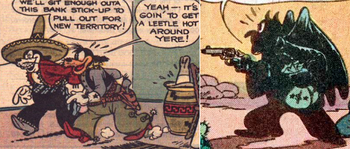
A criminal of many names who uses the image of the Bat Bandit to distract the population from his current civilian identity so he can go on being a crook in peace. His second-in-command, Red Mike, also occasionally dons the Bat Bandit costume.
- Devil in Plain Sight: Minnie is the only one between her, Mickey, and her uncle Mortimer to immediately suspect Don Jollio, but she's mocked by her companions and leaves it be. As the plot progresses, Don Jollio makes several attempts to murder Mickey extremely thinly veiled as accidents but it isn't until he outright tells Mickey he's the Bat Bandit that he catches on.
- Evil Wears Black: The costume of the Bat Bandit is all black. Even his horse has a black coat.
- Funetik Aksent: When presenting as Don Jollio, he puts up a Spanish accent.
- Good Wings, Evil Wings: With Good Animals, Evil Animals on the whole bat dress-up.
- I Have Many Names: The other names given for the Bad Bandit are Don Jollio and Dead-Eye Jake, but as he puts it himself: "To think this is the end o' the "Bat", Don Jollio, Dead-Eye Jake, and all my other names!"
- Legacy Character: Red Mike sometimes fulfills the role of the Bat Bandit, mostly to keep suspicion away from his boss.
- No Name Given: "Jake" probably is the Bat Bandit's civilian name, but it could also be it is not and we don't know what his name is.
- Outlaw: The Bat Bandit and his men would be if they didn't go from place to place adopting new identities to fool people into trusting them.
- The Rustler: The Bat Bandit's list of criminal activity includes rustling. He has stolen cattle from Mortimer, for instance.
The Black Crow
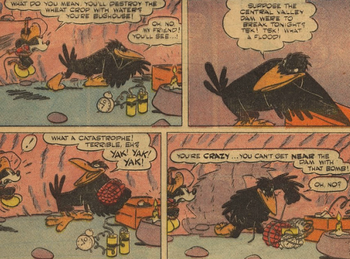
An angered cultivator of prize-winning crops who wasn't as good as he thought he was and therefore dressed up as a crow to murder his betters. His strengths are his cunning and athletism.
- Creepy Crows: He plays the part well.
- Disappointed by the Motive: He won prizes with his crops in the city and then bought a farm so he'd have more space to produce even better crops. But when participating in a crop contest against farmers, he lost. Then he got thrown in jail for trying to stab the winner and he swore he'd destroy everything they have and/or kill them out of revenge. Mickey and the commissioner are stunned by how poor his motive is.
- Don't Go in the Woods: The woods surrounding the farms were his hideout during his revenge spree. Only Mickey dared follow him and was nearly killed the first time and abducted the second.
- Fire/Water Juxtaposition: When burning down the fields and farms doesn't net him the desired results, he tries to blow up the dam to wash it all away.
- No Name Given: He gets no name in the story whatsoever.
- Not Worth Killing: The Black Crow was going to bludgeon Mickey with a rock when he first investigated the woods, but decided it was too messy and that he had bigger fish to fry.
- Only Known by Their Nickname: It's not even a nickname, really. "Black Crow" isn't used as a name in the story and is derived solely from the title.
- "Scooby-Doo" Hoax: He dresses as a crow because farmers hate crows and he hates farmers.
Lawyer Beamish
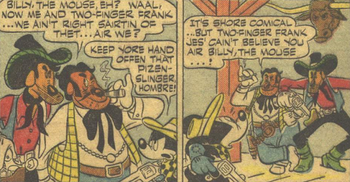
A gangleader in the Wild West who runs the biggest black market beef ring in existence and sometimes robs a train if he feels like it. His right-hand man is Two-Finger Frank.
- Amoral Attorney: Although it does not play a role in the story, he is a lawyer.
- If You're So Evil, Eat This Kitten!: Combined with Impossible Task. They kinda know Mickey isn't Billy and consistently put him to the test with extra measures to ensure that even if he succeeds he won't survive. Needless to say, not a plan of theirs works.
- I Have You Now, My Pretty: Beamish fancies Miss Laramie. One of the challenges he gives Mickey is to kill Ol' Man Laramie for his prize steer Capistrano... and bring back Miss Laramie too while he's at it.
- I Take Offense to That Last One: After multiple counts of attempted murder, train robbery, rustling, and black market activity, Beamish wants it to be clear that he bought the Lazy Daisy Ranch fair and square.
- The Rustler: It's what the gang does.
- They Call Him "Sword": "Two-Finger Frank". Considering he's not missing any digits, it probably refers to his trigger fingers.
Pancho

A cattle rustler. He's got a partner-in-crime named Joe.
- Good Hair, Evil Hair: His moustache avoids suspicion on account of Pancho (probably) being Mexican, but the twirling marks him as definitely up to no good.
- The Nicknamer: He addresses and refers to Minnie as the "leetle lady". He keeps it up even after he is exposed.
- Poirot Speak: There's usually one or two oddities in Pancho's speech, such as referring to himself by name or as "we" or using the wrong verb form. There's a small amount of Funetik Aksent going on too.
- The Rustler: He's Minnie's trusted foreman at the Double-Cross Ranch, which makes it an easy-peasy Inside Job for him to periodically steal her cows. He accomplishes this by having them lifted away by helicopter in pairs.
Gregory Gopher
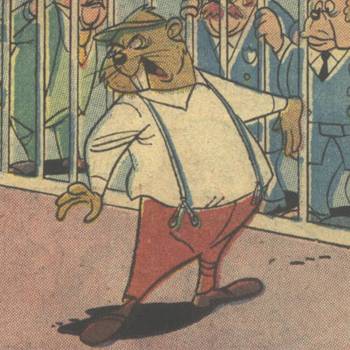
A regular gopher who was mutated in a people-gopher and sought to conquer the world with sapient flora.
- Furry Confusion: He was a regular gopher. Then he mutated and his mutant form was a normal looking people-gopher.
- Green Thumb: He stole the initial technology from Professor Potter, but he's learned fast and adapted the process to his own designs.
- Hoist by His Own Petard: Mickey and Professor Potter tricked Gopher into fearing that the plant people would abandon him if he ever faced tough opposition. To have a decent army, Gopher allowed Potter to make a courage serum and spray it on his plants. What he didn't foresee but his captives sure did was that with courage, the plant people would stand up against him.
- I Control My Minions Through...: Threats of eating them.
- Kill and Replace: The kill phase was postponed long enough for nobody to die before the heroes could get the upper hand, but they were locked away. Gopher used the machine to mutate various plants into the spitting images of his victims. People targeted were Mickey (peanut), Chief O'Hara, Officer Clancy (asparagus), the mayor, and Professor Potter.
- Power Source: The machine that made a Gregory Gopher out of a regular gopher and created sapient plants needed to be on at all times for its effects to last. Potter turned it off the first chance he got.
- Take Over the World: The plant people are deathly afraid of Gregory, but they don't mind dealing with anyone else. Once they've replaced the population, Gregory can easily rule them.
Seaside villains
Doctor Vulter

An aspiring global dictator whose key weapon is a submarine with a claw that can entirely magnetize a vessel, thereby rendering it and any weapons aboard useless. He also has his own island.
- The Dreaded: Really feared by the authorities, and even Mickey, due his ruthlessness and efficiency. Mickey was scared of him before meeting him, just discovering one of the ships captured by his submarine was a battleship had been enough.
- High-Class Glass: Usually on his left eye, but the art isn't 100% consistent.
- Knight of Cerebus: Any story with him around is bound to be more serious than usual simply due the fact Mickey is now facing a terrorist.
- Leave No Survivors: Averted, then played straight. His main interest in the ships are the people on board to force into his army. That is, the men, but women and children are taken captive alongside (implied; it's not made clear if they ever even encountered a ship with anything other than men aboard). Once things go downhill, ship, women, and children are set for destruction every encounter.
- Mad Scientist: He's got the title of doctor.
- Maniac Monkeys: More like a maniac ape (language-adaptions of his name identify him as an orangutan), but you get the picture.
- A Nazi by Any Other Name: Compare the names "Vulter" and "Hitler".
- Submarine Pirates: "The Pirate Submarine". Submarines remain a favorite of his according to the 1998 comic "The Past-Imperfect".
- Take Over the World: His goal.
- Western Terrorists: Explicitely convicted on terrorism charges at least once due his attempts at taking over the world and, in his debut, disrupting the sea routes.
- Would Hurt a Child: Played straight with a hint of Wouldn't Hurt a Child. When he learns the outside world is on to him, he orders a more efficient hunting system. Men are still to be taken captive, but women and children are now to be left to go down with the ships. The order is given during dinner and he takes the moment thereafter for a toast: that the next ship "may contain many men for [their] army and very few women and children to be cosigned to the waves".
Captain Hazzard
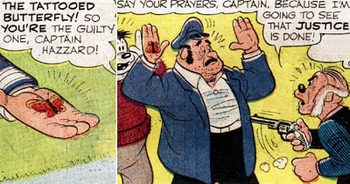
The captain of the "Lucy Belle", a merchant ship.
- Bad People Abuse Animals: He killed a gorilla for, as far as information is given, no reason at all.
- The Captain: Type
 Lawful Evil. Like, a captain is allowed to punish their crew for mutiny, so he'll get them to commit mutiny to make his actions afterwards legal (if disproportionate).
Lawful Evil. Like, a captain is allowed to punish their crew for mutiny, so he'll get them to commit mutiny to make his actions afterwards legal (if disproportionate). - Dogface: One of the hard-to-spot cases, but his ears mark him as such.
- Hoist by His Own Petard: Being the one who killed Pip's other gorilla, it was a matter of time for Pip to realize and turn on him.
- Knight of Cerebus: The setup might have involved three people, but Captain Hazzard is The Determinator that made it happen. So, Professor Pip wants revenge on the man that killed one of his gorillas. He only knows said crook has a butterfly tattoo on his hand. To search for him and enact his revenge without legal interference, he and his remaining gorilla have retreated to an island. Captain Hazzard was hired to bring him criminals, which Pip trusts on Hazzard's word to truly be criminals, so he can check them for the tattoo. Those who aren't the gorilla killer are locked away in a People Zoo for the remaining gorilla to gawk at. To get Pip his crooks, Captain Hazzard hires two new crewman each time he is ashore and insists his orders are to be followed without question. Then he orders them to do something akin to suicide, like jumping from the crow's nest. The crewmen inevitably refuse and are locked up for mutiny on a diet of salt bread and salt water. Pete drops the cell key when serving food so the crewmen, recognizing their impending death, will escape in a life boat and reach Spook's Island on their own volition for Professor Pip to pick up. As the captain, Hazzard has the right to conduct sea burials, which is always what he reports to have happened when the "Lucy Belle" returns to port. Each delivery nets him 200 bucks for a total of 2400 by the time Mickey and Goofy end the thing.
- Large and in Charge: Captain Hazzard's even bigger than Pete.
- Shout-Out: Captain Hazzard is named after the original owner of Spooks the Gorilla as mentioned in "In Search of Jungle Treasure". It does double duty as a Punny Name, with the first character being subjected to hazards enough so to make him lose his mind and this Captain Hazzard being a hazard.
- Sinister Schnoz: He's got a crooked nose that almost seems misplaced on his face.
- Tattooed Crook: He has a butterfly on the palm of his right hand.
Captain Blow
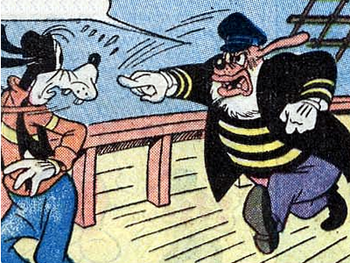
The captain of the "Lazy Gull", a merchant ship. He used to be a circus animal trainer.
- Bad People Abuse Animals: It's implied the whale obeys Captain Blow out of fear. Cue Goofy, Mickey, and Minnie befriending the whale by removing its bad tooth and turning the tables on the captain.
- The Beastmaster: Overlaps thematically with Repulsive Ringmaster. Captain Blow is a corrupt version of The Captain first and foremost, but his past as an animal trainer at the circus gives him a rare edge to put sealife under his control. It shines through whenever he orders around the whale.
- The Captain: He gains his authority not just from being the boss of the ship and a good one at that, but also from being the only one who can prevent the whale from attacking the "Lazy Gull".
- Moby Schtick: Inverted. There's an aggressive whale in the waters around Hoodoo Island that sinks any ship that comes near except for the "Lazy Gull". This is because the whale's been trained by Captain Blow to behave like this so that his crew can salvage the other ships' goods and hide them on Hoodoo Island until a buyer is found.
- Sink The Life Boats: Once he gets wise to Mickey, Goofy, and Minnie being spies, he puts them on a leaky lifeboat in shark-infested waters under the guise of them going to catch fish for the crew to eat.
Enji
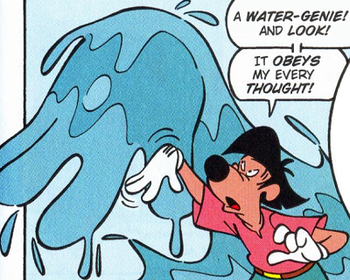
The former assistant of Professor Dhim Sum, a friend of Doc Static. He acquired hydrokinesis for a while.
- Bumbling Sidekick: He did not regard himself as such and considered it an insult when he was fired for gross negligence. However, he cared more about paid breaks than doing a decent job, sneezed around without covering his face when he was sick, and hid a tank of toxic waste instead of disposing of it safely so he could spare himself the drive to the dump.
- Lazy Bum: Lazy (and greedy and not very practical) enough that Mickey could convince him to not destroy the city (and kill Professor Sum with it) until tomorrow because he was just fired, which meant that he had the next 24 hours off with full pay. Enji's not the kind of person to let paid-for lazing about pass him by. When the 24 hours were up, he almost couldn't be bothered to go through with his promise because he'd rather take a nap.
- Making a Splash: Enji gained control over water in a long chain of circumstances. For an exposition themed around man-made brainpower, Professor Sum created a Think Tank, "Molecules with a Mind", or to the point, a unit of water with a small degree of intelligence. This intelligence made it prone to take the shape of people in its vicinity and mimic their movement. Because Enji was (lightly) sick during the exposition, he sneezed into the Think Tank multiple times during maintenance. And because he was lazy, he stashed a tank of toxic waste he was supposed to bring to the dump behind the display. When Mickey played with Doc Static's Rivet the Robot, a radio-helmet-controlled robot, numerous displays were knocked over, including the Think Tank's. The toxic waste poured into it and caused the water to imprint on Enji because of the DNA present, becoming his extension. Enji lead the "water genie", as he dubbed it, to the ocean to contaminate even more water into his service. His powers were undone when he was arrested through trickery and fed a pill to undo the connection.
- Only in It for the Money: Don't think he got a job as Professor Sum's assistant because he cared about science.
- Punny Name: His name is probably meant to sound like "envy". Although "enji" exists as a word in Japan, there aren't any meanings to it that make sense for the character.
- Roaring Rampage of Revenge: Enji's attack on the city is fuelled by a desire for revenge. His main two targets are Professor Dhim Sum for firing him and Mickey Mouse for being the catalyst leading to him being fired. Doesn't help that Sum and Static were praising Mickey behind his back while speaking ill of him in comparison. Because Mickey was the one that caused him to lose face, Enji had the water take the shape of Mickey's head when he launched his attacks.
Evil aristocrats
Duke Varlott

A duke of Medioka. He seeks to dethrone King Michael XIV, his cousin.
- Badass Cape: Varlott wears a travel cloak during his more imposing scenes.
- Engineered Public Confession: Mickey arranges one for Varlott to get him out of the way for Michael's return.
- The Evil Prince: Varlott holds the title of duke and he's Michael's immediate successor would harm befall him. It's a public secret he's been trying to arrange Michael's death for some time. His title plus the fact he hasn't committed a murder yet keep him safe to try again.
- Good Smoking, Evil Smoking: He's a guy and uses a long cigarette holder, so evil smoking. Also, he's evil.
- Man of Wealth and Taste: His introduction shows him in uniform with a long cigarette holder and a wine glass.
- The Usurper: To King Michael XIV. He was arrested after the events of "The Monarch of Medioka", but by heritage remains a candidate for the throne.
The Iron Mask
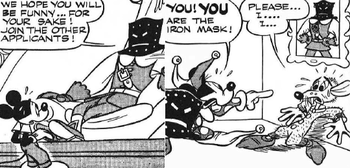
The former ruler of Mousepotamia. He's a scrawny mouse inside a suit.
- Freudian Excuse: He became the Iron Mask because he was weak of will and body and only met cruelty. As the confident and powerful Iron Mask, it is his turn to be cruel.
- Man in the Iron Mask: Inverted. It's the usurper who is hidden behind a mask. He cares a lot about no one knowing he's small and weak underneath.
- Mask of Confidence: The greatest use of Iron Mask's suit. He rarely leaves its safety, going so far as to sleep in it wearing a nightshirt that fits only the suit. No Name Given also comes into play as the character is never identified as anything other than the Iron Mask.
- People's Republic of Tyranny: They do have elections in Mousepotamia. The poster notifying the population of the upcomings one has a small bit at the bottom reading: "P.S. Anyone who does not vote for "The Iron Mask" will be beheaded after leaving the voting booth.".
- Powered Armor: With elements of Monster Suit. A rudimentary one that adds little more strength than appropriate for the size it adds and that has no fancy gadgets. The Iron Mask's suit is the first inclusion of a mecha in a Mickey Mouse comic.
- Shout-Out: The Iron Mask is inspired by The Vicomte of Bragelonne: Ten Years Later. Due to the Ruritania angle, a modern audience might be reminded of Marvel's Doctor Doom, a Marvel villain that debuted in 1962 and was in part inspired by the same novel through its movie adaptations.
- The Usurper: It isn't relayed how Iron Mask came into power and it might have happened lawfully. The story hints against it by bringing up the royal family tree, but that does not mean he wasn't first in line before he proved himself better to be replaced. If he's part of the royal family, he's had 286 family members killed to maintain his reign. If not, then he's just had 286 would-be royals killed for the same reason.
- Villains Never Lie: Played with. The election poster when Iron Mask's power is still secure praises him for being fearless, honest, and kind. When he is allowed to participate in fair elections, he changes his tune to "For president and vice president, "The Iron Mask", an experienced leader, partly honest".
Prince Penguin the First
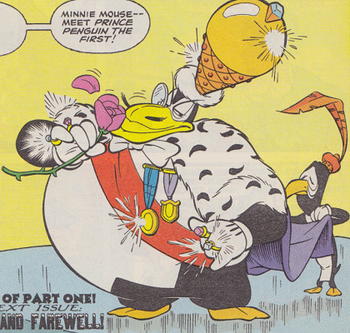
A penguin prince with a love for culture and beauty. He gathered likeminded servants and left his home country to surround himself with the more refined aspects of life. For the most part that means stealing antiques and art and the remaining bit involves freezing over the entire world so he can have cold, which he believes to be necessary for him to live, and culture all at once.
- Affectionate Nickname: Pete calls him "Penny". The affectionate part isn't so much on Pete because he is The Nicknamer, but on Penguin for allowing it.
- Aristocrats Are Evil: He's a ruling prince and evil.
- Cool Crown: A large hoop crown.
- Evil Cannot Comprehend Good: Subverted. Minnie promises to stay with him if he does not harm Mickey. Prince Penguin reasons that if she's willing to give up everything for Mickey, she cannot ever truly love him as long as the mouse is around. Therefore, he makes it an even higher priority to see Mickey dead.
- Evil Virtues: Prince Penguin really likes art. When he is forced to team up with Emil Eagle and Pete to destroy Mickey and Mouseton, his one demand is that they leave the museums unharmed.
- High-Class Glass: On his right eye.
- An Ice Person: He dislikes cold, but believes he needs it to leave and has the means to make everyone else suffer it way more than he does. This is highlighted in the IDW adaption of "Polar Opposition" where in one panel a freeze-villains meeting is mentioned and Prince Penguin namedropped.
- I Have You Now, My Pretty: He is obsessed with Minnie Mouse.
- I'm Melting!: What legend says will happen to Prince Penguin and his people if they ever wade into warm temperatures. It's not true.
- Prince Charmless: He's charming enough that Minnie momentarily forgets he abducted her and tried to kill Mickey and her friends. After she recalls, he's nothing but a condescending and controlling creep.
- Toothy Bird: The occasional teeth for expression purposes aren't notable in a Disney setting. The luscious lips are another story.
- Wicked Cultured: He is fashionable, plays the piano, appreciates good food and fine wine, and surrounds himself with art.
Evil archaeologists
Doctor Kranz
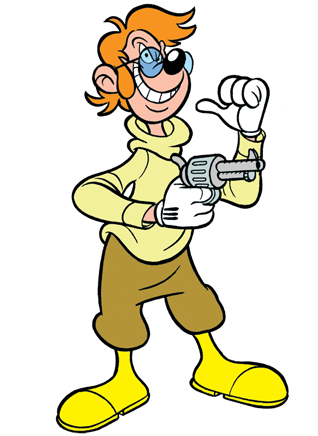
A crooked archeologist. The former partner and current main enemy of Arizona Goof.
- Adventurer Archaeologist: An evil one.
- Affectionate Parody: Of René Belloq from Indiana Jones.
- Master of Disguise: He regularly disguises himself to get what he wants.
- Only in It for the Money: These days, he also wants revenge on Arizona, but money was his original motivation and still his immediate driving force.
- Rival Turned Evil: Kranz and Arizona used to be partners until Arizona figured out that Kranz is only concerned with money and not historical value or the safety of mankind.
The Horde of the Violet Hare

An organization investigating the mysteries of history in hopes of using the findings to Take Over the World. They have a particular interest in Atlantis.
- Adventurer Archaeologist: The more hands-on members of the Horde of the Violet Hare are evil versions of this archetype. Dr. Malvazar in particular qualifies because he joined only after making great discoveries as a regular archaelogist that he wanted to keep for himself.
- Atlantis: What the Horde is after for its Lost Technology, such as the Colossus of Rhodes and orichalcum.
- Eyepatch of Power: Captain Boiler, Zoox's righthand man, has one over his right eye.
- Fang Thpeak: This is how Count Zoox speaks.
- Malevolent Masked Men: Both the mooks and the masters. Most of the time.
- Maniac Monkeys: Dr. Malvazar is a monkey, and "maniac" may actually be an understatement.
- Mooks: Anyone actually dressed as a violet hare.
- Obfuscating Stupidity: The strategy of Count Zoox. He plays the part of an archeology enthusiast with too much money and no brain to hide his illegal mining of orichalcum.
- The Omniscient Council of Vagueness: The Horde is led by a council of ten masters, each given a number. Count Zoox is Master Nine. The highest rank is Grandmaster One.
- Surrounded by Idiots: Grandmaster One feels this way in "Dark Mines of the Phantom Metal" and considers getting involved with the search personally.
- Sword Cane: Count Zoox has a gun disguised as cane.
- Take Over the World: The organization's goal through military means.
Doctor Jacques Le Bron

A knowledgeable but crooked egyptologist who is an enemy of Katarina Kodorofsky. He's usually accompanied by his butler Jenkins
- Adventurer Archaeologist: An evil one who is specialized in Egyptian history.
- The Collector: Not under normal circumstances, but he did plan to seal Katarina up in a sarcophagus and make his nemesis part of his collection that way.
- Darkness Equals Death: There's some ambiguity on account of Jacques being a coward when he's not in full control of the situation, but his panic when the light goes off does suggest some presence of scotophobia.
- The Jeeves: Jenkins is one, going to Battle Butler if they situation needs it. He usually talks with a refined accent too and the only time it slipped is when Katarina proved a competent combatant.
- Mister Big: Le Bron is a shorty and is at the head of a gang which members are all taller than him. With Jenkins he specifically forms Big Guy, Little Guy.
- Villain: Exit, Stage Left: In the backstory of "Catch As Catch Can". Katarina talks about how she tipped Interpol on Le Bron's illegally obtained collection of precious antiquities. Interpol did find it, but they couldn't pin anything on Le Bron because he could show provenance for each item and claimed he was duped by others. Ever since, Katarina has kept an eye on him waiting for another opportunity and Le Bron hates her for costing him his original collection.
- Villain with Good Publicity: Le Bron is a highly respected authority on Egyptian history, which is why nobody suspects him of keeping artifacts for himself. After he loses his first collection, he sets up his second in a secret room in the tomb of Aktupset only he knows of. He can do this because he arranged to have the tomb closed off for research for a year. He and his students, actually henchmen, are then free to get everything set up as Le Bron pleases.
- Wicked Cultured: You want to know what his speech balloon in his debut panel contains?:Le Bron: "I think you'd better turn the music off, Jenkins! I can't concentrate on both Vivaldi and this exquisite acquisition!"
Evil scientists
Professors Ecks, Doublex, and Triplex

A trio of evil monkey scientists. Triplex is the leader, Ecks and Doublex the mostly deferring, occasionally independent disaster duo.
- Aborted Arc: In Disney's Mickey Mouse Adventures, a fusion of Professors Ecks and Doublex named Doctor Doublecross shows up. Various hints were given that Doublecross was, in fact, a separate entity from the two professors. In "The Riddle of the Runaway Sphinx!", they talk about a joint duplication ray and cloning experiment in relation to their merged predicament. The multiparter ends in "The Curse of the Cross-Eyed Kolli", which sees the doctor get assistance from a band of ninjas whose faces are never revealed, whose identity is never given, and whose numbers are also unclear although they do always operate in sets (there are at least two sets). Without any sort of explanation, Doctor Doublecross and the ninjas simultaneously disappear on the final page. Furthermore, the editorials of issues #4 and #5 contain the comments "we're not saying that Doctor Doublecross is (or isn't) related to the classic Floydd Gottfredson villains" and "or someone who strongly resembles them". One guess would be that both the doctor and the ninjas were meant to be duplicates of the professors and that their sudden disappearance relates to this, but as per the trope, no resolution came before Mickey Mouse Adventures was cancelled.
- Barefoot Cartoon Animal: Triplex goes around without shoes. At the time of his creation, lack of shoes was still a recurring design choice for characters. That changed only a few years later, but once the professors returned to the comics, Triplex was kept shoeless because it is one of the details distinguishing him from his colleagues.
- Black Eyes of Evil: One of Doublex's differences from the other two are his black eyes with white pupils.
- Chuck Cunningham Syndrome: Starting with "The Time Transmuter" in 1990, Triplex was suddenly dropped from the group. He didn't return until 1997 in "Bats In The Belfry", not counting a 2-page "Blaggard Castle" summary comic and the ode-heavy "Perils of Mickey". Even the 1994 "Blaggard Castle" remake omitted Triplex.
- Expy: A case of Decomposite Character to Composite Character. "Blaggard Castle" is based on the 1933 short The Mad Doctor, starring the Mad Doctor as the villain. Professors Ecks, Doublex, and Triplex in design and name are based on him. The 1995 short Runaway Brain featured Dr. Frankenollie as villain, who is similar to Ecks, Doublex, and Triplex because he is a monkey, a mad scientist, and a fan of trap doors. In fact, Frankenollie was originally intended to be Professor Ecks until orders from above led to the creation of a new character.
- Fusion Dance: In the Mickey Mouse Adventures comic book, Professor Ecks and Professor Doublex (or their duplicates) returned as a two-headed being known as Dr. Doublecross, which was a result of them being fused together by a mishap with a cloning ray.
- Heel–Face Brainwashing: Their first story ended with Mickey using their hypno-ray against them and making them become good scientists.
- Heel–Face Revolving Door: In spite of being hypnotized into being good, subsequent stories featuring them would have them become bad again, with two different explanations. The sequel, "Perils of Mickey", established that the hypno-ray, while making them good, didn't keep them sane, which resulted in them earning jail time anyway. The 1995 comic story "Ecks and Doublex Reform" went with revealing that the scientists went back to their evil ways after being hit by water balloons, as water was capable of undoing the effects of the ray's hypnosis.
- Hoist by His Own Petard: As said under Heel–Face Brainwashing, their original story ended with Mickey using their invention against the professors and hypnotizing them into being good. They were put to the same defeat again in "Just Be Nice!", although Mickey restored their old personalities right after they'd undo the damage they'd caused.
- Hypno Ray: They spent their first appearance perfecting one and have since regularly returned to mind-influencing inventions.
- Labcoat of Science and Medicine: All three wear them all the time. Triplex's is a slightly different design.
- Mad Scientist: All three of 'em.
- Maniac Monkeys: All of them are monkeys and all of them wish to perform heinous experiments.
- Master Computer: In "The Coming Of Quadruplex" and "Quadruple Threat", the professors work to create a supercomputer they've named Quadruplex to help in their schemes. The machine is designed to be dependent on brain input and they've so far tried to get Mickey's and Sam Simian's for it. Triplex also threatened to use Ecks's and Doublex's if they didn't stop bumbling.
- Shark Pool: The professors have a pit full of alligators in Blaggard Castle. It hides one of the building's secret passages.
- Terrible Trio: Triplex being the domineering one with Ecks and Doublex as the henchmen.
- Trap Door: The professors love these and Mickey knows to expect at least one if he's in or near one of their hideouts.
Professor McMonk
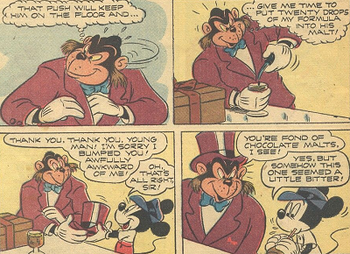
A scientist who invented a concoction to turn people's laughter glass-shattering.
- Maniac Monkeys: His actions cause people to be afraid to laugh, which has its effect on society.
- Mirthless Laughter: What he makes the people of Mouseton go through by making their laughter destructive.
- Sharp-Dressed Man: A suit with a top hat. He uses the hat to distract Mickey.
- Stage Magician: Implied to be something of the kind. He orders a drink with an egg in it specifically to make an "only if it's fresh" remark and get a laugh out of Mickey when the barista breaks open the egg and a chick jumps out.
- Trademark Favorite Food: Orange root beer with an egg in it.
Doctor Orridus
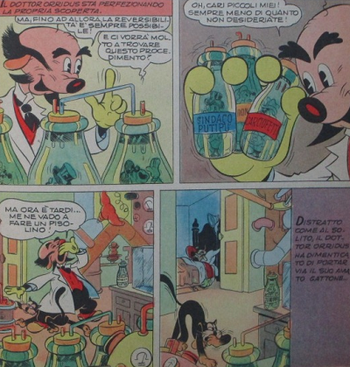
An evil scientist.
- Beard of Evil: He's got, like, a double goatee!
- Island Base: It's heavily guarded by his henchmen while he's at work in his lab at the highest point.
- Mad Scientist: He shrank people, put them in jars, and sought to make it permanent just because he could.
- Right-Hand Cat: He allows it to roam the laboratory while he's working. He forgot to take it with him once while having some shrunken people on display, which nearly had them killed.
- Shrink Ray: He targets people with it.
Doctor Flor T. Winx
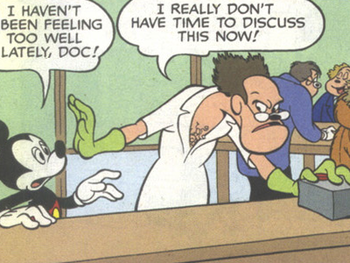
A maniacal scientist whose expertise lies with dreams.
- Carpet of Virility: Winx wears a lowcut labcoat and nothing underneath, so his chest hair is not something one easily looks past.
- Dream Walker: Overlaps with Dream Stealer and Dream Weaver. In "The Stuff Of Dreams", he has a machine he can hook up people to so they can enter each other's dreams. He uses the access to plant a dream syphon in his victim's mind and steal their dream potential. He notes that he's improving his tech to eventually not need the physical connection anymore. In "A Nightmare on Mickey's Street", he wants revenge and sics nightmares on Mickey using his new equipment.
- Hoist by His Own Petard: In "The Stuff Of Dreams", not only does Goofy chase Winx out of his dream by making up creatures to fight him, but Mickey also follows Winx into his dream and steals it from him. Winx doesn't get his dream potential back until he comes along to the police station to confess what he's been up to.
- Labcoat of Science and Medicine: Some people wear a t-shirt, others wear a sweater, and Winx wears a labcoat. His kind of research doesn't even require one.
- Mad Scientist: His plan is to steal people's dreams both to sell them back, as people whose dreams have been taken can't get rest from sleeping anymore, and to make real and unleash on whatever he has decided to target for a robbery.
- Punny Name: "Flor T. Winx" evokes "forty winks", a somewhat poetic term to indicate a short nap just enough to revitalize.
- Shout-Out: The first half of "The Stuff Of Dreams" is very similar to Runaway Brain, with Minnie desiring something expensive, Mickey responding to an ad asking for subjects for brain-related research to afford it, and being left altered by the experiment until he solves the case. Doctor Winx takes the role of Doctor Frankenollie in this setup.
Supernatural villains
Doctor Grut
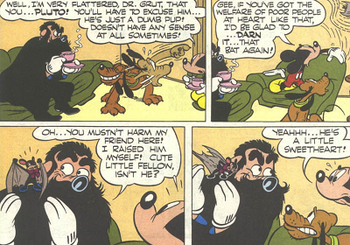
A mad scientist who utilizes mindless slaves named aberzombies as his servants and who wishes to turn people into trees.
- Beard of Evil: His face is barely visible behind the thick black beard until Mickey causes it to disappear with the 'lectro box. He's mostly distressed because he had a formula for poison gas recorded on a fine silk wire that was hidden in the beard.
- Gothic Horror: He enjoys the atmosphere and has dressed up his home accordingly. The bat and octopus pet as well as the zombies help too.
- Mad Scientist: That whole thing with turning a few people into aberzombies - he's got four and tried to make Mickey the fifth - and planning to turn the rest into trees. He does call it research into "sorcery and the black arts", so there's some Evil Sorcerer in there too.
- Older Than They Look: The doctor looks about 50. His age is not given, but his oldest aberzombie is 220 years old which presumably only refers to his time as zombie. This would make Grut about 250 years old, if not more.
- Tickle Torture: Does this to Mickey after examining him for the torture he's most suspectible to.
- Well-Intentioned Extremist: Turning people into trees is to "relieve suffering and overcrowding". Of course, that just might be a sadist's excuse.
- Zombify the Living: Grut has turned four people into aberzombies. He also tried to do this to Mickey, but the latter escaped.
Drusilla
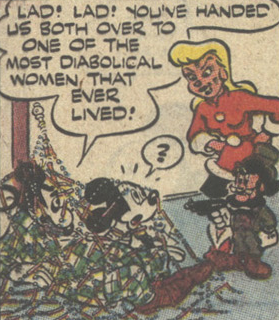
A chemistry genius who made herself immortal and created herself a simple but effective underground criminal empire using mind-controlled minions. On occasion she hired willing henchmen, such as Jeremiah Jemson, who is implied to have been her companion since the early days. She may or may not have a dog (it disappears after it fulfills its job, but does not appear to be under mind control).
- Evil Gloating: She lets Maximilian do the work for her. "Go on, old man! Tell him the story! It will amuse me...!"
- Face of an Angel, Mind of a Demon: Drusilla is a pretty young woman with a fashion sense between "modern" and "cute". She's kind and caring... until it's time to drop the act and get on with being an immortal kingpin.
- Just One Little Mistake: Maximilian is a detective known to work cases for alleged criminals. Drusilla mistook him for someone who'd work for her, but he stole the anti-ageing formula to stop her instead. He also did research on her origins and came across a tintype from the 1870s. This tintype's existence ends up being Mickey's cue that Drusilla is untrustworthy.
- Mad Scientist: She's a brilliant chemist who at the age of 17, before she was even done with her study, already had created two amazing but terrible concoctions: one to hypnotize people to do her bidding and one to halt the ageing process.
- Meaningful Name: Drusilla is a name with little popularity on account of it being the name of the favored sister and of the daughter of Caligula.
- Mind Control: By means of her first potion invented.
- Older Than They Look: Is about ninety years of age, looks not a day older than seventeen.
- Papa Wolf: Jeremiah to Drusilla. Despite his size (a head smaller than Mickey), he's a very capable fighter in her service. He also calls her endearments like "Little Drusilla" and "Missy".
- Platonic Life-Partners: Drusilla and Jeremiah. Mind that while they're probably about as old (by now, anyway), Drusilla is physically 17 and Jeremiah looks to be in his forties.
- "Scooby-Doo" Hoax: Drusilla is adapt at making a place seem haunted. She uses this to frame Mickey's great-uncle Maximilian Mouse.
- Self-Disposing Villain: Drusilla willingly re-enters a burning house with further risk of explosion to save her formulas. Jeremiah runs after her so as to not be left alone. Neither of them comes back out.
- Ugly Hero, Good-Looking Villain: She's the good-looking villain to Maximilian's ugly hero.
- Undying Loyalty: Jeremiah to Drusilla.
- Wounded Gazelle Gambit: Drusilla has herself walled in inside Maximilian's home and claims he did it because she found out he was a murder. This she does to make Mickey cooperative in taking down the one man who managed to stop her crimes.
Mr. Fox

A crooked real estate agent who wanted to scare Mickey's neighborhood away with hauntings so he could buy for cheap. He hired Professor Murk for this, who wasn't quite the type for crime despite his big words.
- The Con: A real estate variety: he has ghosts harass the neighborhood until people sell him their houses at a low price.
- Cunning Like a Fox: The villainous sort. He'd also figured Professor Murk wasn't tough enough, but gave him a chance anyway.
- Karma Houdini: Mr. Fox doesn't get his cheap houses, but he also doesn't get any consequences from his scheme being exposed.
- No Name Given: He lacks a forename. If one assumes he's the same character as the salesman A. Fox from a 1953 gag comic (same writer, different artist), at least his first name is known to start with an "A".
- "Scooby-Doo" Hoax: The ghosts as conjured up by Professor Murk are real, but they were harmless until Mr. Fox gave him money to scare everyone away.
- Shady Real Estate Agent: No evidence he would sell bad homes while keeping the flaws secret, but, hey, he's a jerk and it'd be the only way to get Goofy's house sold.
The Itching Gulch Gang
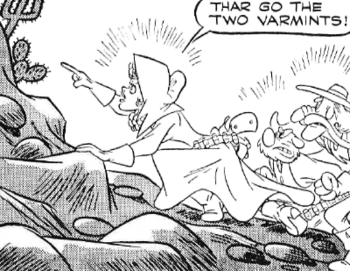
An effectively immortal gang of criminals led by an unnamed woman.
- Bad Guy Bar: It's really only run by and for the gang these days, but The Last Gasp Saloon qualifies.
- Bad People Abuse Animals: Thoroughly subverted. The gang has plenty of animals as pets they seem to treat lovingly, including a bear, a rattlesnake, and buzzards. In fact, when Mickey and Eega Beeva locate their horses to make an escape, the horses outright betray the duo by notifying the gang of their location.
- Black Widow: The leader. She's been married and widowed at least eleven times and is currently looking for a new husband. Her involvement with their deaths is unclear as she shares that they all "died kind of sudden-like", with the exception of Two-Card Dan who died a "natural death" from being bitten by her pet rattlesnake.
- Don't Make Me Destroy You: The signs outside Itching Gulch: "Itching Gulch Is Just Ahead" "Don't Say We Didn't Warn You!" "Please Take Another Route Instead" "Or All Will Surely Mourn You!".
- Fluffy the Terrible: Before reaching Itching Gulch, there's a road sign providing directions to it, Calamity Flat, Burning Skull, Spook Mesa, Awful Hot Junction, and Gave-Out Springs. Mickey and Eega Beeva naturally picked Itching Gulch — a terrible mistake.
- Fountain of Youth: Underneath Itching Gulch is a teenite mine. Teenite is an ore that when liquidized makes the drinker younger. It also makes them glow. Meta-wise, teenite is a fictionalized and sensationalized adaption of uranium, which at the time of the comic's writing was highly sought-after.
- Ghost Town: Itching Gulch is one.
- Just Between You and Me: The leader really likes to show off the teenite and the youth it grants. It's just too bad she has to kill most of the audience she gets to preserve the secret.
- No Name Given: With the exception of the (presumably) second-in-command, Cactus Tex, not a single member of the gang is given a name.
- Older Than They Look: The entire gang regularly rejuvenates themselves by drinking teenite and has been doing so for a little below a century. The leader confides she's actually 98 years old, while the last entry of the guest registry in the Savvy Hotel dates from April 19, 1871, which is 78 years ago at the time of the events of "Itching Gulch".
- Orcus on His Throne: The gang doesn't actually do anything but protect the teenite, which is more or less legally theirs anyway. They aren't even all that murderous to people who come to Itching Gulch despite the warnings as they will put up a ghost show first to try to scare them away.
- Our Ghosts Are Different: The gang aren't actually ghosts. They're people who, by consuming teenite, gain eternal life and an eerie pale glow that makes it easy for them to pretend to be ghosts to keep away curious outsiders. However, the leader and Tex make appearances as real ghosts in the Donald Duck comic "The Haunted Houses".
- Outlaw: A supernatural variant.
- Power Echoes: The Cave of the Don't-Die Echoes forms the entrance to the teenite mine. By unknown means (it might be a trick), it forever repeats any lines uttered in and around Itching Gulch that involved a life-or-death situation. The lines given are "Please don't shoot!", "Hands up!", "Halp!", "They went thetaway, sheriff!", "Take thet, yuh thievin' rattlesnake!", "BANG! BANG!", "Tex, yuh old hossthief!", "String up the critter!", and "Yuh wouldn't shoot me in thuh back?".
- "Scooby-Doo" Hoax: The "ghosts" are real, but the powers they display are not. That is, one ghost that takes his head off is explicitly tricking Mickey and Eega Beeva witha fake head. On the other hand, the leader can shoot bullets with her mouth, which seems real enough. Another ghost that floats would seem to be a trick to scare Mickey and Eega Beeva away, but no confirmation is given. In any case, the gang plays up the ghost town properties of Itching Gulch to scare away any visitors, preferring not to resort to murder unduly.
Phantasmo
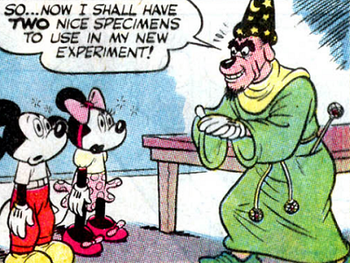
A sorcerer who uses television to reach as many people as possible to hypnotize into serving him. If he exists at all.
- All Just a Dream: With the lightest trace of Or Was It a Dream?. After defeating Phantasmo by burning his magic wand, Minnie remarks she wishes none of these awful events had happened. Mickey says that if he still had the wand, he'd wave it and make it all nothing more than a bad dream. As he makes the gesture, the scene shifts to Minnie's house, where she wakes him up because he had fallen asleep in front of her television set.
- Animorphism: He's experimenting with turning people into animals so he can sell them to zoos and circuses.
- Genre Savvy: He has a tendency to refer to Mickey, Minnie, and Goofy as "the heroes". When Mickey, who'd been stealthing up to that point, bursts into the room to save Minnie, Phantasmo is not the least bit fazed, simply commenting: "Aha! A gallant young hero to the rescue!"
- Haunted Castle: Phantasmo's home. Only thing missing is that it's technically not haunted, but it still is full of creepy and unexplainable opportunities to die.
- I Have You Now, My Pretty: Sort of to Minnie. He wants her to join him and teach her the black arts, but it's not clarified why she's of interest to him.
- Magic Wand: Phantasmo derives most of his power from one. Once it is thrown in the fire, all his spells are undone.
- Magitek: Phantasmo's magic is the traditional kind, but he's experimenting with ways to incorporate technology in his spells. His focus for the time being is making victims through televised magic.
- Mass Hypnosis: People were disappearing all over town because he did this.
- Robe and Wizard Hat: You're not going to get it anymore classic than Phantasmo's outfit.
- Shout-Out: Phantasmo is inspired by Doctor Grut and Drusilla. One servant of Phantasmo even looks to be an aberzombie, while the hypnosis panels are reminiscent of the effects of Drusilla's concoction.
Doctor Doom
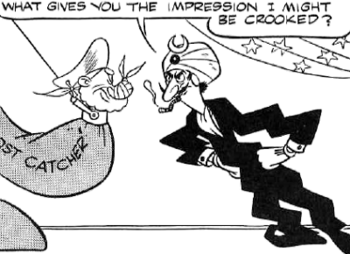
A collector of ghosts and head of Happy Criminals, Inc.
- Bizarre Human Biology: Well, dogface, but you get the idea. His entire body is crooked. One panel shows him down to his bones and they're crooked too. No explanation for why he is this way is given.
- Card-Carrying Villain: When Black Brian tells Doctor Doom there's something wrong with him, the reply is thoroughly matter-of-fact: "Of course there is! How do you suppose I could do this sort of work if there weren't?"
- Collector of the Strange: He collects ghosts. If they are useful as henchmen, they may roam free. If not, in jars they go.
- Dogface: One of the hard-to-spot cases, but his ears mark him as such.
- Fauxreigner: Lightly; he leaves the "sahib" and "o, master" stuff for customers he has to sucker into staying long enough to be turned into servants.
- Good Smoking, Evil Smoking: Even his cigarette holder is crooked!
- Hypnotic Eyes: Doctor Doom uses them to put his victims to sleep before their operation.
- Impact Silhouette: He gets blown through the roof when the explosives he's holding go off. All that's left is a perfectly crooked hole.
- Leonine Contract: He inflicts Tickle Torture on ghosts he's captured until they sign up for Happy Criminals, Inc.
- Mad Scientist: He's got a lab for human experimentation and by his own admission is not alright.
-
 Older Than They Think: He predates the more famous Marvel character (introduced in 1962) by over a decade.
Older Than They Think: He predates the more famous Marvel character (introduced in 1962) by over a decade. - Zombify the Living: Implied to be how he gets living servants. Tried to do this with Mickey, but Mickey escaped.
The Phantom Gondolier
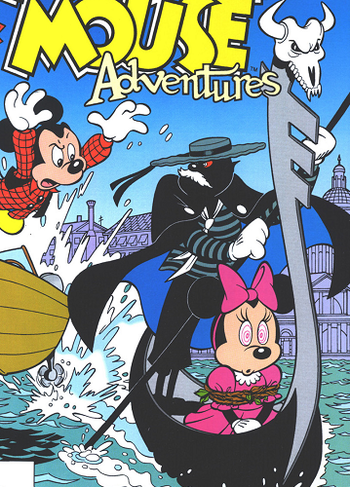
The 400 years-old ghost of an Italian magician. He was in love with Elizabeta di Mousini, but she did not return his feelings and when he persisted her father noticed her terrified state and had the magician locked away. Before being dragged off, he gave Elizabeta an enchanted necklace that, would she wear it, would ensure he'd find her. She never did and the necklace made it through heritage to her great-great-great-niece, from whom Minnie accidentally took it.
- Claimed by the Supernatural: The means of the claim is the necklace given to Elizabeta di Mousini 400 years ago.
- Cool Boat: His gondola.
- Green Thumb: Thanks to his magic panpipes.
- I Have You Now, My Pretty: Even after 400 years, he still pines for Elizabeta di Mousini. He operates by the logic that whoever wears the necklace he gave her is Elizabeta, so Minnie Mouse becomes his target.
- Love Makes You Evil: He already was evil, but at least he didn't use to have a Touch of Death or was looking to drag anyone to the Shadowland. Mickey even feels sorry for him before realizing he doesn't really deserve it.
- Magical Flutist: He wields triple-tube panpipes to hypnotize and command plants.
- Magical Accessory: The necklace the magician gave to Elizabeta.
- Mind Control: Thanks to his magic panpipes.
- Never Say "Die": His ghostly home is the Shadowland.
- No Name Given: His name when alive is not given and he's almost solely referred to as the Evil One. He's only referred to as the Phantom Gondolier once and that would look like a description were it not for the story's title.
- Touch of Death: He's got it.
- Unrequited Love Lasts Forever: It's been 400 years.
- When the Clock Strikes Twelve: He has to claim his bride by rowing past the Rialto Bridge before midnight or he has to return home alone.
Half-villains
Kat Nipp

A tough cat whom Mickey occasionally clashes with. Although criminal, Mickey's encounters with him rarely are about that.
- Ambiguously Gay: Mickey infamously called Kat Nipp a "cream-puff inhaler" while beating up an obviously gay cat coming out of Nipp's house. The meaning of "cream-puff inhaler" is debated, but generally assumed to mean "person associating with (inhaling) men not in line with the conventional idea of masculinity (cream-puff)".
- The Bully: Kat Nipp's general characterization after "Mickey Mouse Vs. Kat Nipp".
- Cats Are Mean: The intended interpretation of his character, whether it works or not.
- Characterization Marches On: Kat Nipp was a tough guy with some territorial tendencies in his early appearances, but he wasn't villainous at all. In fact, Mickey was the one to provoke him, leaving him no peace in a one-upmanship he never asked for. Later comics added a criminal element to Kat Nipp (he's even been in jail according to "Kerst Zware Jongens"), presumably to justify his status as an enemy of Mickey.
- The Family That Slays Together: According to "Mickey's 'Hoozoo' Witswitch, And Wotswot", Kat Nipp has a sister named Claws who's possibly even worse than he is.
- The Rival: In "Mickey Mouse Vs. Kat Nipp" to Mickey. Big time.
Hickup
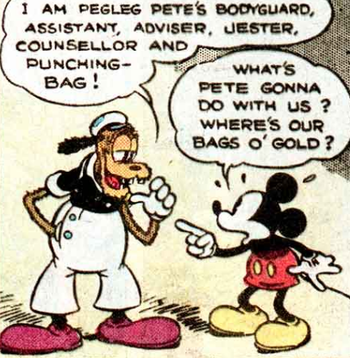
One of Pete's partners-in-crime he didn't treat so well.
- Comedic Sociopathy: Although Pete by far is shown as someone who is not unpleasant to work with, this isn't always the case and Hickup gets treated exceptionally poorly. As he puts it himself, he's Pete's personal punching bag. In one scene, Pete beats him up solely so Hickup knows he'll be beaten up if he flunks his assigned task. Another scene has Hickup beating up himself to show Pete he knows what violence awaits him if he fails. This is all Played for Laughs.
- Even Evil Has Standards: Pete was considered as fine a crime leader as any until he tried to force Minnie to marry him. That's when the crew turned against him, mutiny or not. Hickup, being a victim of abuse by Pete, responds a little differently than the rest of the crew, but not on Pete's behalf.
- Hiccup Hijinks: Hickup's predicament is, you guessed it, that he suffers hiccups without reason or ending. He seems fine with it.
- No Name Given: Either "Hickup" is a nickname for his ailment or it's a Meaningful Name. Most likely the former.
- Reformed Criminal: Vaguely implied. Because they helped him arrest Pete, Mickey testified for the entire crew and helped them get light sentences. As he puts it, "they are not really criminals like Pete". (A tad odd since they tried to hang him once or twice.)
- The Stoic: Hinted to overlap with Broken Bird. The closest to losing his cool is when Mickey and Minnie get out of their chains when he was supposed to guard them. He politely asks them to go back because Pete will take it out on him if they escape.
Swifty

One of Pete's partners-in-crime he didn't treat so well.
- Agent Provocateur: Swifty keeps pestering Mickey if he's interested in some royal intrigue and when Mickey agrees to listen out of politeness, Swifty takes that as his cue to arrest him with clear conscience.
- Conspicuous Trenchcoat: The trenchcoat on its own is actually not that conspiciuous but then you combine it with blatantly hiding in garbage cans and it's a wrap.
- Consummate Professional: Swifty is a balance between being this and wanting to be this. He's good, but also negatively affected by self-doubt. Because Mazumia is at peace, he's not of much use as a member of the secret police and he hates to still get a paycheck out of being useless.
- The Dog Bites Back: Pete should not have made plans to off Swifty just to cover his tracks and to not have to share the loot.
- Honor Among Thieves: Despite being the one to get Pete out of jail and in charge of Mazumia while he hangs around as just a member of the secret police who is rewarded with a kick to the behind for bringing in Mickey, Swifty hides behind the door just in case Pete needs help to deal with the mouse.
- Reformed Criminal: What he promised Mickey after he defeated Pete. Considering they never met again, Swifty's probably keeping to his word.
Meanie Markham
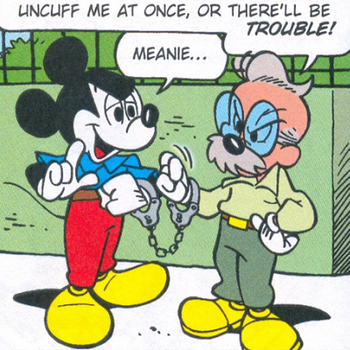
Once one of Mickey's kindergarten schoolmates, who nobody wanted to be friends with due to his hostile attitude. He, however, blames their (nonexistent) jealousy of his intelligence.
- Adults Dressed as Children: Overlaps with Master of Disguise. Due to his size, Meanie needs to make few adjustments to himself to pass for a child.
- Chick Magnet: Played for Laughs at the end of "The Town That Hated Mickey". Mickey felt sorry for Meanie at the end of the hate ordeal and secretly fed him the antidote so people would like Meanie. Meanie finds he doesn't like being liked at all, having built his identity around being an outcast, and runs away in terror from the women flocking around him.
- Friendless Background: Self-generated. He was a bully as child, constantly beating up other kids. However, he did not perceive it as him starting things, but rather him responding to being excluded.
- Hate Plague: His plan to take revenge on Mouseton involved this. He'd feed everyone Eau de Hate so they'd destroy each other. He also created a Love Potion as antidote.
- Inferiority Superiority Complex: As bad as it gets. He insists he has no friends because people are jealous of his smarts. He hates anything he can find a way to perceive as questioning his intelligence and will do the work to cut off any accusation, although he also is convinced he never has "done anything that's good enough". He both pities himself for being hated and takes pride in (in his perception) generating a strong sense of loathing in others. He embraces being a loner, but breaks down from acknowledging his loneliness.
- Mad Scientist: He studied the molecular origins of hate and created the pheromone-based Eau de Hate. He also made a Love Potion as antidote for the Hate, not realizing the Love could be used on its own too.
- One-Steve Limit: Averted with the existence of Mr. Meanie, although in his case it's his surname while in Markham's case it's his forename.
- Pintsized Powerhouse: Maybe, maybe not. As a small child he was strong enough to terrorize his classmates, but they were the same height as he was back then. His physical strength is likely to still be impressive, but it is unknown how he holds up to anyone bigger than him.
- The Rival: Because Mickey is the most popular guy Meanie ever met, he was all too happy to trick him into drinking Eau de Hate first and watch him suffer.
Delilah
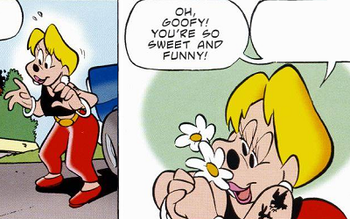
A woman who committed complex robberies for the thrill of it. She dragged Goofy along when she dated him, but regretted doing that to him.
- Classy Cat-Burglar: A more down-to-earth version.
- Meaningful Name: Delilah is the name of the Biblical figure who caused the downfall of her partner for personal gain.
- Reformed Criminal: Delilah has said she regrets getting Goofy involved in her life of crime for which he only avoided the same two years she got because Chief O'Hara vouched for him. She's vowed to get out herself and turned their budding romance into a penpalship. Of course, she doesn't know (yet) that Goofy sabotaged the theft and got her arrested on purpose...
- Storyboard Body: Overlaps with Tattooed Crook. Delilah has a tattoo on her left shoulder of a hawk hunting a rabbit. Combined with her name, Goofy really should've made a 180 when she opened the door for him.
- Thrill Seeker: The primary reason Delilah commits robberies.
